Nokia Solutions and Networks T6HG1 CDMA Base Station User Manual Exhibit 8a
Nokia Solutions and Networks CDMA Base Station Exhibit 8a
Contents
- 1. Exhibit 8a
- 2. Exhibit 8b
Exhibit 8a

September 12, 2007
Communication Certification Laboratory
1940 West Alexander St
Salt Lake City, UT 84119
Re: FCC Part 15 notation page update to draft version of BTS/Optimization Manual
for FCC filing IHET6HG1
To whom it may concern:
Motorola has submitted a draft format 1X Macro UBS BTS Optimization/ATP
manual for TCB review and approval of IHET6HG1 UBS CDMA XMI Transceiver
at 1.9GHz, which will be updated with FCC required manual information similar to
the example on page 2 of this letter, in the next and/or final released drafts.
A draft of the page to be included in the updated manual will be provided to TCB to
keep on file, and the updated manual including the FCC Part 15 reference page will
be provided for reference when it becomes available.
If you have any questions or concerns, please feel free to contact me at (817) 245-
6039 or via email at Melissa.VanDrie@Motorola.com
Regards,
Melissa VanDrie
Motorola, Inc.
BTS FCC Coordinator
FCC ID Number IHET6HG1
FCC Requirements
This section presents Federal Communication Commissions (FCC) Rules Part 15 requirements and
compliance information for the USB CDMA XMI Transceiver @ 1.9 GHz.
Part 15.19a(3) – Information To User
NOTE This device complies with Part 15 of the FC Rules, Operation is subject to the
following two conditions:
1. This device may not cause harmful interference, and
2. This device must accept any interference received, including interference that
may cause undesired operation.
Part 15.21 – Information To User
CAUTION Changes or modifications not expressly approved by Motorola could void your
authority to operate the equipment.
Part 15.105(b) - Information To User
NOTE This equipment has been tested and found to comply with the limits for a Class B
digital device, pursuant to Part 15 of the FCC Rules. These limits are designed to
provide reasonable protection against harmful interference in a residential
installation. This equipment generates, and uses and can radiate radio frequency
energy and, if not installed and used in accordance with the instructions, may cause
harmful interference to radio communications. However, there is no guarantee that
interference will not occur in a particular installation. If this equipment does cause
harmful interference to radio or television reception, which can be determined by
turning the equipment OFF and ON, the user is encouraged to try to correct the
interference by one or more of the following measures:
- Reorient or relocate the receiving antenna.
- Increase the separation between the equipment and receiver.
- Connect the equipment into an outlet on a circuit different from that to which the
receiver is connected.
- Consult the dealer or an experienced radio/TV technician for help.
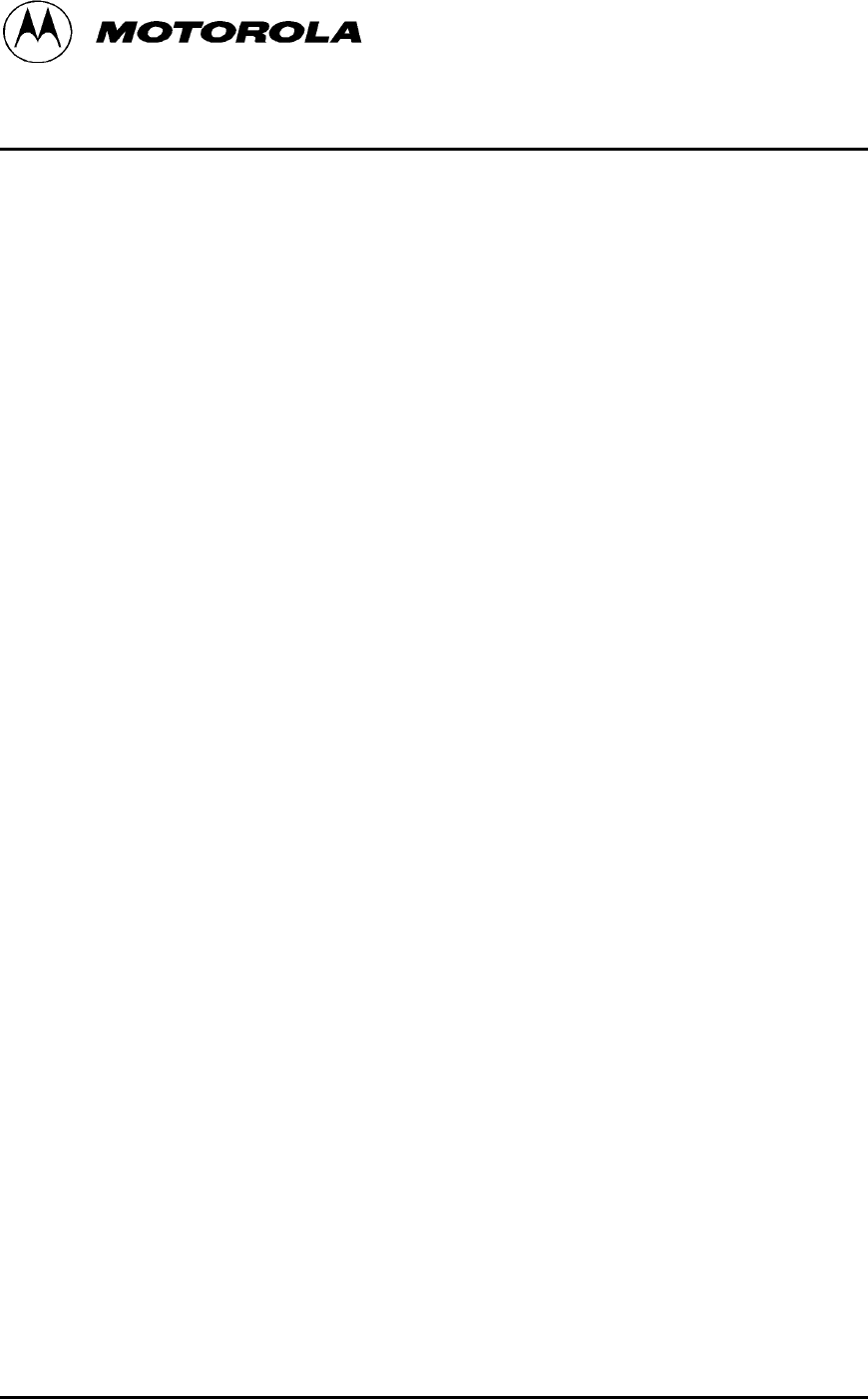
APPLICANT: MOTOROLA
Cellular Networks
FCC ID: IHET6HG1
Installation Manual Exhibit
UBS CDMA XMI Transceiver at 1.9GHz
FCC Filing – UBS CDMA XMI Transceiver at 1.9GHz (cover page)

R20 1X UBS Macro BTS Hardware Installation
68P09283A62 -2 AUG 2007
PRELIMINARY
© 2007 Motorola, Inc. All Rights R eserv ed
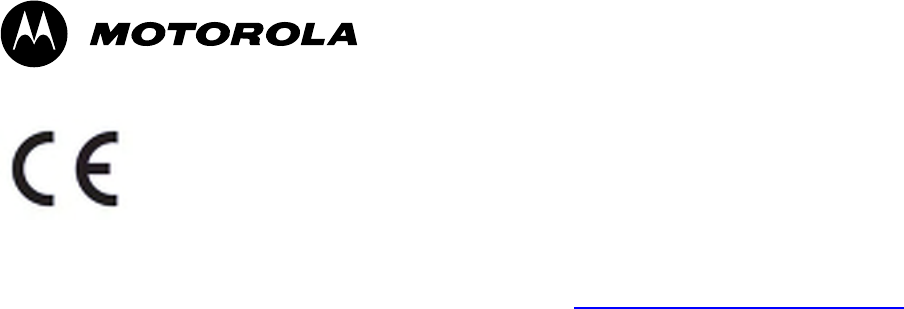
Accuracy
While reasonable efforts have been made to assure the accuracy of this document, Motorola, Inc. assumes no
liability resulting from any inaccuracies or omissions in this document, or from use of the information obtained
herein. Motorola, Inc. reserves the right to make changes to any products described herein to improve reliability ,
function, or design, and reserves the right to revise this document and to make changes from time to time in content
hereof with no obligation to notify any person of revisions or changes. Motorola, Inc. does not assume any liability
arising out of the application or use of any product, software, or circuit described herein; neither does it convey
license under its patent rights or the rights of others. It is possible that this publication may contain references to, or
information about Motorola products (machines and programs), programming, or services that are not announced
in your country . Such references or information must not be construed to mean that Motorola intends to announce
such Motorola products, programming, or services in your country .
Copyrights
This document, Motorola products, and 3rd P arty Software products described in this document may include
or describe copyrighted Motorola and other 3rd P arty supplied computer programs stored in semiconductor
memories or other media. Laws in the United States and other countries preserve for Motorola, its licensors, and
other 3rd P arty supplied software certain exclusive rights for copyrighted material, including the exclusive right
to copy , reproduce in any form, distribute and make derivative works of the copyrighted material. Accordingly ,
any copyrighted material of Motorola, its licensors, or the 3rd P arty software supplied material contained in the
Motorola products described in this document may not be copied, reproduced, reverse engineered, distributed,
merged or modified in any manner without the express written permission of Motorola. Furthermore, the purchase
of Motorola products shall not be deemed to grant either directly or by implication, estoppel, or otherwise, any
license under the copyrights, patents or patent applications of Motorola or other 3rd P arty supplied software,
except for the normal non-exclusive, royalty free license to use that arises by operation of law in the sale of a
product.
A list of 3rd P arty supplied software copyrights are contained in the Supplemental information section of this
document.
Restrictions
Software and documentation are copyrighted materials. Making unauthorized copies is prohibited by law . No part
of the software or documentation may be reproduced, transmitted, transcribed, stored in a retrieval system, or
translated into any language or computer language, in any form or by any means, without prior written permission
of Motorola, Inc.
License Agreements
The software described in this document is the property of Motorola, Inc and its licensors. It is furnished by express
license agreement only and may be used only in accordance with the terms of such an agreement.
High Risk Materials
Components, units, or 3rd P arty products used in the product described herein are NOT fault-tolerant and are NOT
designed, manufactured, or intended for use as on-line control equipment in the following hazardous environments
requiring fail-safe controls: the operation of Nuclear F acilities, Aircraft Navigation or Aircraft Communication
Systems, Air Traffic Control, Life Support, or W eapons Systems (High Risk Activities). Motorola and its supplier(s)
specifically disclaim any expressed or implied warranty of fitness for such High Risk Activities.
T rademarks
Motorola and the Stylized M Logo are registered in the US P atent & Trademark Office. All other product or service
names are the property of their respective owners.
The CE mark confirms Motorola, Inc. statement of compliance with EU directives applicable to this product. Copies
of the Declaration of Compliance and installation information in accordance with the requirements of EN50385 can
be obtained from the local Motorola representative or by contacting the Customer Network Resolution Center
(CNRC). The 24 hour telephone numbers are listed at h t t p s : / / m y n e t w o r k s u p p o r t . m o t o r o l a . c o m . Select Customer
Network Resolution Center contact information. Alternatively if you do not have access to CNRC or the
internet, contact the Local Motorola Office.
PRELIMINARY A UG 2007

T a b l e
o f
C o n t e n t s
Contents
■■■■■■■■■■■■■■■■■■■■■■■■■■■■■■■■■■■■■■■■■■■■■■■■■■■■■■■■■■■■■■
■
■
■
■
R20 1X UBS Macro BTS Hardware Installation
Revision history ......................................... 3
Version information ..................................... 3
Resolution of Service Requests . . . . . . . . . . . . . . . . . . . . . . . . . . . . . . . 3
Incorporation of Change Notices . . . . . . . . . . . . . . . . . . . . . . . . . . . . . . . 3
General information ....................................... 4
Purpose ........................................... 4
Cross references ....................................... 4
Text conventions ....................................... 5
Contacting Motorola ....................................... 6
24–hour support ....................................... 6
Questions and comments .................................. 6
Errors ............................................ 6
Security advice .......................................... 7
W arnings, cautions, and notes . . . . . . . . . . . . . . . . . . . . . . . . . . . . . . . . . . 8
W arnings ........................................... 8
Cautions ........................................... 8
Notes ............................................ 8
Safety .............................................. 9
General safety ........................................ 9
Electromagnetic energy ................................... 9
Caring for the environment . . . . . . . . . . . . . . . . . . . . . . . . . . . . . . . . . . . 10
In EU countries ....................................... 10
In non -EU countries ..................................... 10
CMM labeling and disclosure table . . . . . . . . . . . . . . . . . . . . . . . . . . . . . . . 11
Motorola document set ..................................... 12
Ordering documents and CD -ROMs . . . . . . . . . . . . . . . . . . . . . . . . . . . . . 12
Document banner definitions . . . . . . . . . . . . . . . . . . . . . . . . . . . . . . . . 12
Data encryption ....................................... 12
Third P arty Computer Software and Trademarks . . . . . . . . . . . . . . . . . . . . . . . . 13
Computer Software ..................................... 13
Trademarks ......................................... 13
Chapter 1: Introduction and Frame Identication
Abbreviations and Acronyms . . . . . . . . . . . . . . . . . . . . . . . . . . . . . . . . . . . 1 - 2
Abbreviations and Acronyms . . . . . . . . . . . . . . . . . . . . . . . . . . . . . . . . . 1 - 2
Overview ............................................. 1 - 5
Scope of manual ....................................... 1 - 5
Prerequisites ......................................... 1 - 5
Chapter 1 - Introduction and frame identification . . . . . . . . . . . . . . . . . . . . . . 1 - 5
Chapter 2 – UBS Macro BTS installation procedure . . . . . . . . . . . . . . . . . . . . . 1 - 6
Chapter 3 - Low -to -Mid Capacity Frame Expansion Procedures . . . . . . . . . . . . . . . 1 - 6
68P09283A62 -2 i
A UG 2007 PRELIMINARY
Contents
Chapter 4 -What’s next ................................... 1 - 6
Equipment shipped assembled . . . . . . . . . . . . . . . . . . . . . . . . . . . . . . . . 1 - 6
Equipment shipped un -assembled . . . . . . . . . . . . . . . . . . . . . . . . . . . . . . 1 - 6
Follow the task sequence .................................. 1 - 7
Follow the site plan ..................................... 1 - 7
Site cleanliness ....................................... 1 - 7
Site manager ......................................... 1 - 7
Color coding ......................................... 1 - 7
R ack vs. frame ....................................... 1 - 8
Required documentation ................................... 1 - 8
Equipment may vary from figures . . . . . . . . . . . . . . . . . . . . . . . . . . . . . . 1 - 8
Item identification ........................................ 1 - 9
UBS Macro BTS frames ................................... 1 - 9
Items to be installed ..................................... 1 - 15
Tools and materials ....................................... 1 - 16
Required tools and materials . . . . . . . . . . . . . . . . . . . . . . . . . . . . . . . . . 1 - 16
Recommended tools ..................................... 1 - 17
Unpacking Instructions ..................................... 1 - 18
Unpacking the carrier strip assembly . . . . . . . . . . . . . . . . . . . . . . . . . . . . 1 - 18
Unpacking accessory equipment . . . . . . . . . . . . . . . . . . . . . . . . . . . . . . . 1 - 20
Chapter 2: UBS Macro BTS Installation Procedure
Overview ............................................. 2 - 2
Introduction ......................................... 2 - 2
Structural engineer ..................................... 2 - 2
Required items ........................................ 2 - 2
Cabling and configuration options . . . . . . . . . . . . . . . . . . . . . . . . . . . . . . 2 - 2
Color coding ......................................... 2 - 2
Cable list, diagrams and connectors . . . . . . . . . . . . . . . . . . . . . . . . . . . . . . . 2 - 4
Overview ........................................... 2 - 4
UBS Macro BTS external I/O cable run list . . . . . . . . . . . . . . . . . . . . . . . . . 2 - 4
Connector locations ..................................... 2 - 6
Full installation sequence . . . . . . . . . . . . . . . . . . . . . . . . . . . . . . . . . . . . 2 - 11
Overview ........................................... 2 - 11
Prerequisites ......................................... 2 - 11
V erifying site and equipment . . . . . . . . . . . . . . . . . . . . . . . . . . . . . . . . . 2 - 11
Physical installation ..................................... 2 - 11
Site verification ......................................... 2 - 15
Site installation checks . . . . . . . . . . . . . . . . . . . . . . . . . . . . . . . . . . . 2 - 15
Temperature range ..................................... 2 - 16
Frame physical dimensions . . . . . . . . . . . . . . . . . . . . . . . . . . . . . . . . . 2 - 16
Frame clearances ...................................... 2 - 16
Frame DC input power and power cabling information . . . . . . . . . . . . . . . . . . . 2 - 17
Frame positioning ...................................... 2 - 18
R ack base description and dimensions . . . . . . . . . . . . . . . . . . . . . . . . . . . . 2 - 18
T ask 1: Installing RGPS Head . . . . . . . . . . . . . . . . . . . . . . . . . . . . . . . . . . 2 - 20
Objective ........................................... 2 - 20
RGPS head installation .................................... 2 - 20
T asks 2 -3: Installing R ack & Ground Cable . . . . . . . . . . . . . . . . . . . . . . . . . . . 2 - 28
Objective ........................................... 2 - 28
R ack requirements ...................................... 2 - 28
Structural engineer prerequisite . . . . . . . . . . . . . . . . . . . . . . . . . . . . . . . 2 - 28
Required items ........................................ 2 - 29
Location of rack earth ground terminals . . . . . . . . . . . . . . . . . . . . . . . . . . . 2 - 30
Procedure .......................................... 2 - 30
T ask 4: R ack Mounting the Optional PSM Shelf . . . . . . . . . . . . . . . . . . . . . . . . . 2 - 32
Objective ........................................... 2 - 32
ii 68P09283A62 -2
PRELIMINARY A UG 2007
R20 1X UBS Macro B T S Hardw are Installation Contents
Required items ........................................ 2 - 32
Procedure .......................................... 2 - 32
Procedural reference diagrams . . . . . . . . . . . . . . . . . . . . . . . . . . . . . . . 2 - 34
T ask 5: R ack Mounting for Low -Capacity Frame . . . . . . . . . . . . . . . . . . . . . . . . . 2 - 36
Objective ........................................... 2 - 36
Required items ........................................ 2 - 36
Procedure .......................................... 2 - 37
Procedural reference diagrams . . . . . . . . . . . . . . . . . . . . . . . . . . . . . . . 2 - 39
T ask 6: Expanding the Low -capacity Frame . . . . . . . . . . . . . . . . . . . . . . . . . . . 2 - 45
Objective ........................................... 2 - 45
Procedure .......................................... 2 - 45
T ask 7: Cabling the Optional PSM Shelf . . . . . . . . . . . . . . . . . . . . . . . . . . . . . 2 - 46
Objective ........................................... 2 - 46
Required items ........................................ 2 - 46
Procedure .......................................... 2 - 46
T asks 8 -9: Connecting TX/RX Antennas . . . . . . . . . . . . . . . . . . . . . . . . . . . . . 2 - 47
Objective ........................................... 2 - 47
Required items ........................................ 2 - 47
Location of antenna connectors . . . . . . . . . . . . . . . . . . . . . . . . . . . . . . . 2 - 47
Procedure .......................................... 2 - 47
T asks 10 -13: Connecting RGPS , Spans, Customer Alarms . . . . . . . . . . . . . . . . . . . . 2 - 49
Objective ........................................... 2 - 49
Cabling options ....................................... 2 - 49
Required items ........................................ 2 - 50
Location of cables AA, W and X . . . . . . . . . . . . . . . . . . . . . . . . . . . . . . . 2 - 50
Balanced T1/E1 cable (W) details . . . . . . . . . . . . . . . . . . . . . . . . . . . . . . 2 - 50
Customer alarm input/output (IP/OP) cable (X) details . . . . . . . . . . . . . . . . . . . . 2 - 52
T ask 14: Connecting +27 V DC P ower . . . . . . . . . . . . . . . . . . . . . . . . . . . . . . 2 - 58
Objective ........................................... 2 - 58
Frame power cables and connector information . . . . . . . . . . . . . . . . . . . . . . . 2 - 58
Required items ........................................ 2 - 59
P ower cabling and tie down requirements . . . . . . . . . . . . . . . . . . . . . . . . . . 2 - 60
Contact/lug, DC connector housing and PDU input power . . . . . . . . . . . . . . . . . . 2 - 60
Procedure .......................................... 2 - 61
T ask 15: Connecting -48 V DC P ower . . . . . . . . . . . . . . . . . . . . . . . . . . . . . . 2 - 63
Objective ........................................... 2 - 63
Frame power cables and connector information . . . . . . . . . . . . . . . . . . . . . . . 2 - 63
Required items ........................................ 2 - 64
P ower cabling and tie down requirements . . . . . . . . . . . . . . . . . . . . . . . . . . 2 - 65
Contact/lug, DC connector housing and PDU input power . . . . . . . . . . . . . . . . . . 2 - 65
Procedure .......................................... 2 - 66
T ask 16: Connecting 220 V AC P ower . . . . . . . . . . . . . . . . . . . . . . . . . . . . . . 2 - 68
Objective ........................................... 2 - 68
Frame AC power cables and wiring information . . . . . . . . . . . . . . . . . . . . . . . 2 - 68
Required items ........................................ 2 - 69
AC PSM shelf AC power input detail . . . . . . . . . . . . . . . . . . . . . . . . . . . . . 2 - 69
Procedure .......................................... 2 - 71
Chapter 3: Low -to -Mid Capacity Frame Expansion Procedures
Low -to -Mid Capacity Frame Expansion Overview . . . . . . . . . . . . . . . . . . . . . . . . 3 - 2
How to use this chapter ................................... 3 - 2
Adding Circuit Breakers/Connectors to PDU . . . . . . . . . . . . . . . . . . . . . . . . . . . 3 - 3
Objective ........................................... 3 - 3
Required items ........................................ 3 - 3
Procedure .......................................... 3 - 4
Procedural reference diagram . . . . . . . . . . . . . . . . . . . . . . . . . . . . . . . . 3 - 6
Adding an XMI .......................................... 3 - 7
68P09283A62 -2 iii
A UG 2007 PRELIMINARY
Contents
Objective ........................................... 3 - 7
Required items ........................................ 3 - 7
Procedure .......................................... 3 - 8
Procedural reference diagram . . . . . . . . . . . . . . . . . . . . . . . . . . . . . . . . 3 - 9
Adding a DMI .......................................... 3 - 10
Objective ........................................... 3 - 10
Required items ........................................ 3 - 10
Prerequisite ......................................... 3 - 11
Procedure .......................................... 3 - 11
Procedural reference diagram . . . . . . . . . . . . . . . . . . . . . . . . . . . . . . . . 3 - 13
Adding a Second Set of IDRFs . . . . . . . . . . . . . . . . . . . . . . . . . . . . . . . . . . 3 - 14
Objective ........................................... 3 - 14
Required items ........................................ 3 - 14
Procedure .......................................... 3 - 15
Procedural reference diagram . . . . . . . . . . . . . . . . . . . . . . . . . . . . . . . . 3 - 16
Adding an Optional RX Splitter . . . . . . . . . . . . . . . . . . . . . . . . . . . . . . . . . 3 - 17
Objective ........................................... 3 - 17
Required items ........................................ 3 - 17
Procedure .......................................... 3 - 17
Procedural reference diagram . . . . . . . . . . . . . . . . . . . . . . . . . . . . . . . . 3 - 18
Adding a second/third PSM (–48 V or 220 V AC only) . . . . . . . . . . . . . . . . . . . . . . 3 - 19
Objective ........................................... 3 - 19
Required items ........................................ 3 - 19
Procedure .......................................... 3 - 20
Mid -capacity Expansion Interconnect Cabling . . . . . . . . . . . . . . . . . . . . . . . . . . 3 - 21
Objective ........................................... 3 - 21
Installing DC power cables . . . . . . . . . . . . . . . . . . . . . . . . . . . . . . . . . . 3 - 21
Installing/Connecting RF cables (XMI to IDRF) . . . . . . . . . . . . . . . . . . . . . . . 3 - 23
Installing XMI to DMI cables . . . . . . . . . . . . . . . . . . . . . . . . . . . . . . . . . 3 - 26
Installing DMI to S SI cables . . . . . . . . . . . . . . . . . . . . . . . . . . . . . . . . . 3 - 27
Installing RX splitter to XMI RX RF cables or RX share cable . . . . . . . . . . . . . . . . 3 - 28
Chapter 4: What’s Next
Installation completion ...................................... 4 - 2
Clean up the site ....................................... 4 - 2
Fill out the installation completion checklist . . . . . . . . . . . . . . . . . . . . . . . . . 4 - 3
Record “ As -Built” information . . . . . . . . . . . . . . . . . . . . . . . . . . . . . . . . 4 - 4
Performing the ATP s..................................... 4 - 4
Loading the software .................................... 4 - 4
iv 68P09283A62 -2
PRELIMINARY A UG 2007

L i s t
o f
F i g u r e s
List of Figures
■■■■■■■■■■■■■■■■■■■■■■■■■■■■■■■■■■■■■■■■■■■■■■■■■■■■■■■■■■■■■■
■
■
■
■
Figure 1 -1: UBS Macro BTS low -tier/low -capacity frame (1000 mm rack) . . . . . . . . . . . . 1 - 10
Figure 1 -2: Low capacity UBS Macro BTS starter frame (1800 mm rack) . . . . . . . . . . . . 1 - 11
Figure 1 -3: UBS Macro BTS mid -capacity frame (1800 mm rack) . . . . . . . . . . . . . . . . 1 - 12
Figure 1 -4: High capacity 800 MHz UBS Macro BTS fully expanded frame . . . . . . . . . . . 1 - 13
Figure 1 -5: High -capacity 1.9 GHz UBS Macro BTS fully expanded frame (1800 mm rack) . . . 1 - 14
Figure 1 -6: Items to install . . . . . . . . . . . . . . . . . . . . . . . . . . . . . . . . . . . . 1 - 15
Figure 1 -7: Carrier strip assembly with inner carton support . . . . . . . . . . . . . . . . . . 1 - 19
Figure 1 -8: Carrier strip assembly with inner carton support removed . . . . . . . . . . . . . 1 - 19
Figure 2 -1: 800 MHz IDRF I/O connectors . . . . . . . . . . . . . . . . . . . . . . . . . . . . 2 - 7
Figure 2 -2: 1.9 GHz IDRF I/O connectors . . . . . . . . . . . . . . . . . . . . . . . . . . . . 2 - 7
Figure 2 -3: S SI front panel connectors . . . . . . . . . . . . . . . . . . . . . . . . . . . . . . 2 - 9
Figure 2 -4: PSM shelf front panel connectors . . . . . . . . . . . . . . . . . . . . . . . . . . 2 - 10
Figure 2 -5: R ack footprint . . . . . . . . . . . . . . . . . . . . . . . . . . . . . . . . . . . . 2 - 19
Figure 2 -6: RGPS cabling diagram . . . . . . . . . . . . . . . . . . . . . . . . . . . . . . . . 2 - 21
Figure 2-7: RGPS wiring ..................................... 2 - 22
Figure 2 -8: RGPS lightning arrestor wiring . . . . . . . . . . . . . . . . . . . . . . . . . . . 2 - 23
Figure 2-9: RGPS heads ..................................... 2 - 24
Figure 2 -10: Installing the RGPS head . . . . . . . . . . . . . . . . . . . . . . . . . . . . . . 2 - 25
Figure 2 -11: Connector pin numbering for cables NN and AA . . . . . . . . . . . . . . . . . . 2 - 26
Figure 2 -12: Location of ground terminals on a Motorola rack . . . . . . . . . . . . . . . . . . 2 - 30
Figure 2 -13: Hanger screw layout for the optional PSM shelf . . . . . . . . . . . . . . . . . . 2 - 34
Figure 2 -14: Hanging the PSM shelf . . . . . . . . . . . . . . . . . . . . . . . . . . . . . . . 2 - 35
Figure 2 -15: Hanger screw layout for UBS Macro carrier strip assembly . . . . . . . . . . . . 2 - 40
Figure 2 -16: Removing the XMI from the carrier strip assembly . . . . . . . . . . . . . . . . . 2 - 41
Figure 2 -17: Lifting and hanging the carrier strip assembly on the rack (XMI shown
removed) ............................................. 2 - 42
Figure 2 -18: Carrier strip assembly keyhole screw locations . . . . . . . . . . . . . . . . . . 2 - 43
Figure 2 -19: Reinstalling the XMI . . . . . . . . . . . . . . . . . . . . . . . . . . . . . . . . 2 - 44
Figure 2 -20: T1/E1 balanced span line cable (W) pin numbering . . . . . . . . . . . . . . . . . 2 - 50
Figure 2 -21: Customer alarm cable (X) pin numbering . . . . . . . . . . . . . . . . . . . . . . 2 - 54
Figure 2 -22: +27 V DC power input cable (DC) wire tie -wrap example . . . . . . . . . . . . . 2 - 60
Figure 2 -23: +27 V DC power input cable (DC) connector and connection to PDU . . . . . . . . 2 - 61
Figure 2 -24: 48 V DC power input cable (CC) wire tie -wrap example . . . . . . . . . . . . . . 2 - 65
Figure 2 -25: 48 V DC power input cable (CC) connector and connection to PSM shelf . . . . . . 2 - 66
Figure 2 -26: AC PSM shelf AC power input terminal block and wiring details . . . . . . . . . . 2 - 70
Figure 3 -1: Adding a Breaker Assembly Module to the PDU . . . . . . . . . . . . . . . . . . . 3 - 6
Figure 3 -2: Installing a 2nd XMI . . . . . . . . . . . . . . . . . . . . . . . . . . . . . . . . . 3 - 9
Figure 3 -3: Installing a 2nd DMI . . . . . . . . . . . . . . . . . . . . . . . . . . . . . . . . . 3 - 13
Figure 3 -4: Installing the second set of IDRFs . . . . . . . . . . . . . . . . . . . . . . . . . . 3 - 16
Figure 3 -5: Mounting the RX splitter . . . . . . . . . . . . . . . . . . . . . . . . . . . . . . 3 - 18
68P09283A62 -2 v
A UG 2007 PRELIMINARY

L i s t
o f
T a b l e s
List of Tables■■■■■■■■■■■■■■■■■■■■■■■■■■■■■■■■■■■■■■■■■■■■■■■■■■■■■■■■■■■■■■
■
■
■
■
T able 1: Manual version history . . . . . . . . . . . . . . . . . . . . . . . . . . . . . . . . . 3
T able 1 -1: Abbreviations and Acronyms . . . . . . . . . . . . . . . . . . . . . . . . . . . . . 1 - 2
T able 2 -1: Color code – DC power connectors/cables . . . . . . . . . . . . . . . . . . . . . . 2 - 3
T able 2 -2: Color code - RF Equipment and Connectors/Cables . . . . . . . . . . . . . . . . . . 2 - 3
T able 2 -3: UBS Macro BTS external I/O cable run list . . . . . . . . . . . . . . . . . . . . . . 2 - 4
T able 2 -4: Frame dimensions . . . . . . . . . . . . . . . . . . . . . . . . . . . . . . . . . . 2 - 16
T able 2 -5: Minimum frame clearances for airflow . . . . . . . . . . . . . . . . . . . . . . . . 2 - 16
T able 2 -6: Minimum frame clearances for maintenance - front access only . . . . . . . . . . . 2 - 16
T able 2 -7: Minimum frame clearances for maintenance - front and rear access . . . . . . . . . 2 - 17
T able 2 -8: +27 V DC and –48 V DC Frame P ower Cabling and P ower Supply Breaker
Information ........................................... 2 - 17
T able 2 -9: List of required cables for RGPS head installation . . . . . . . . . . . . . . . . . . 2 - 20
T able 2 -10: Pinout for cables NN and AA . . . . . . . . . . . . . . . . . . . . . . . . . . . . 2 - 26
T able 2 -11: T1/E1 I/O cable W (span) signal and pin information . . . . . . . . . . . . . . . . 2 - 51
T able 2 -12: Customer alarm cable (X) pinout for customer IP 1 -12 OP 1 -4 . . . . . . . . . . . . 2 - 54
T able 2 -13: Customer alarm cable (X) pinout for customer IP 13 -24 OP 5 -8 . . . . . . . . . . . 2 - 55
T able 2 -14: +27 V DC connector (Orange) parts information . . . . . . . . . . . . . . . . . . 2 - 58
T able 2 -15: –48 V DC connector (Blue) parts information . . . . . . . . . . . . . . . . . . . . 2 - 64
T able 4 -1: Installation completion checklist . . . . . . . . . . . . . . . . . . . . . . . . . . . 4 - 3
68P09283A62 -2 vii
A UG 2007 PRELIMINARY

A b o u t
T h i s
M a n u a l
R20 1X UBS Macro BTS Hardware
Installation
■■■■■■■■■■■■■■■■■■■■■■■■■■■■■■■■■■■■■■■■■■■■■■■■■■■■■■■■■■■■■■
■
■
■
■
The R20 UBS Macro BTS supports single band 800 MHz or 1.9 GHz RF band, up to
two XMIs, up to two DMIs and one S SI. UBS Macro BTS frame configurations with up
to four XMIs and up to five DMIs will be available in the future.
What is covered in this manual?
The UBS Macro BTS Hardware Installation manual describes the installation of Motorola
supported configurations of the UBS Macro BTS system. The UBS Macro BTS system supports
either the 800 MHz or the 1.9 GHz RF band and IP -packet backhaul. In addition, CDMA 1X and
CDMA EV -DO channels are supported as well as Open Transport Interface (OTI) for IP -packet
backhaul via Ethernet. The UBS Macro BTS frame can also be configured for +27 V DC
operation, optional -48 V DC or optional 220 V AC operation.
The UBS Macro BTS air interface supports the following:
•Omni or 3–sector antenna configurations
•Single RF band operation only; 800 MHz or 1.9 GHz RF band
•Up to 120 W of total TX RF power output and up to 30 W TX RF power output per carrier
•Dual path, Main and Diversity , RX antennas
UBS Macro BTS frames are also configured for low , mid, or high capacity . Capacity is determined
by the quantity of sector carriers and traffic channels supported by the frame. The quantity of
sector carriers is a function of the quantity of XMIs. The quantity of traffic channels is a function
of the quantity of modems. Because the modems are inside the DMI, the quantity of DMIs is a
capacity factor . The capacity of a UBS Macro BTS frame is essentially based on the following:
•low capacity - one XMI and up to two DMIs
•mid capacity - two XMIs and two DMIs
•high capacity - more than two XMIs (four XMIs maximum) and more than two DMIs (four
DMIs maximum)
68P09283A62 -2 1
A UG 2007 PRELIMINARY

F or Software Release 2.20.x, only low and mid capacity frames are available/supported.
High capacity UBS Macro BTS frames will be available in the future.
The manual covers the following topics:
•Chapter 1 provides a brief description of the information presented in the manual, frame
identification information, installation sequence, and a list of tools.
•Chapter 2 provides illustrations displaying the location of all UBS Macro connectors for
external cabling and wiring purposes, external cable run list, and a detailed installation
sequence. Installation procedures cover mounting items to the rack and installing the
external cabling.
•Chapter 3 provides information and procedures needed for expanding the low -capacity
UBS Macro BTS starter/expansion frame to the mid -capacity frame configuration.
•Chapter 4 provides procedures for cleaning up the site and the installation completion
checklist.
2 68P09283A62 -2
PRELIMINARY A UG 2007
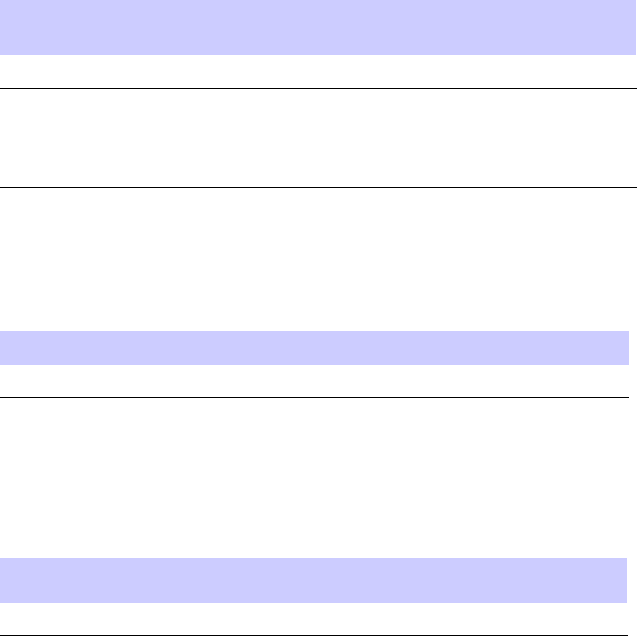
R evision history
Revision history■■■■■■■■■■■■■■■■■■■■■■■■■■■■■■■■■■■■■■■■■■■■■■■■■■■■■■■■■■■■■■
■
■
The following shows the issue status of this manual since it was first released.
Version information
Table 1 Manual v ersion history
Manual
issue
Date of issue
Remarks
1 JUN 15, 2007
DRAFT version for SME review
2 AUG 10, 2007
PRELIMINAR Y version for
SME review . Does not include
E -GPS and the special recently
requested SPRINT mechanics.
Resolution of Service Requests
The following Service Requests are resolved in this document:
Service Request CMBP Number
Remarks
NA NA NA
Incorporation of Change Notices
The following Change Notices (CN) are incorporated in this document:
CN Date CN Number
T itle
NA NA NA
68P09283A62 -2 3
A UG 2007 PRELIMINARY

Gener al information
General information
■■■■■■■■■■■■■■■■■■■■■■■■■■■■■■■■■■■■■■■■■■■■■■■■■■■■■■■■■■■■■■
■
■
Purpose
Motorola cellular communications documents are intended to instruct and assist personnel in
the operation, installation and maintenance of the Motorola cellular infrastructure equipment
and ancillary devices. It is recommended that all personnel engaged in such activities be
properly trained by Motorola.
Motorola disclaims all liability whatsoever , implied or express, for any risk of damage, loss or
reduction in system performance arising directly or indirectly out of the failure of the customer ,
or anyone acting on the customer’s behalf , to abide by the instructions, system parameters,
or recommendations made in this document.
These documents are not intended to replace the system and equipment training offered by
Motorola. They can be used to supplement and enhance the knowledge gained through such
training.
If this document was obtained when attending a Motorola training course, it will
not be updated or amended by Motorola. It is intended for TRAINING P URPOSES
ONL Y . If it was supplied under normal operational circumstances, to support a major
software release, then corrections are supplied automatically by Motorola and posted
on the Motorola customer website.
Cross references
References made to external publications are shown in italics. Other cross references,
emphasized in blue text in electronic versions, are active links to the references.
This document is divided into numbered chapters that are divided into sections. Sections are
not numbered, but are individually named at the top of each page, and are listed in the table of
contents.
4 68P09283A62 -2
PRELIMINARY A UG 2007
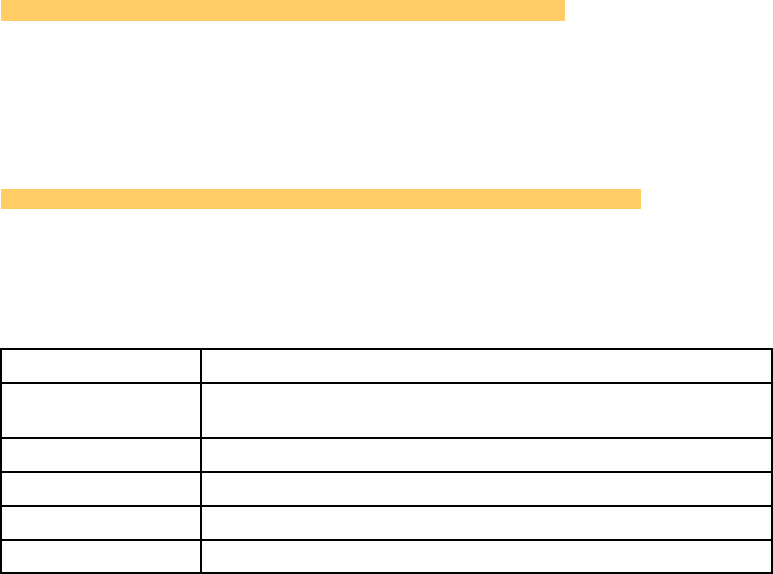
Gener al information
Text conventions
The following conventions are used in the Motorola cellular infrastructure documents to
represent keyboard input text, screen output text, and special key sequences.
Input
Characters typed in at the keyboard are shown like this.
Items of interest within a command appear like this.
Output
Messages, prompts, file listings, directories, utilities, and environmental
variables that appear on the screen are shown like this.
Items of interest within a screen display appear like this.
Special key sequences
Special key sequences are represented as follows:
CTRL-c or CTRL+C
Press the Ctrl and Ckeys at the same time.
CTRL-SHIFT-c or
CTRL+SHIFT+C
Press the Ctrl ,Shift , and Ckeys at the same time.
ALT-f or ALT+F
Press the Alt and Fkeys at the same time.
ALT+SHIFT+F11
Press the Alt ,Shift and F11 keys at the same time.
¦Press the pipe symbol key .
RETURN or ENTER
Press the Return or Enter key .
68P09283A62 -2 5
A UG 2007 PRELIMINARY
Contacting Motorola
Contacting Motorola■■■■■■■■■■■■■■■■■■■■■■■■■■■■■■■■■■■■■■■■■■■■■■■■■■■■■■■■■■■■■■
■
■
Motorola appreciates feedback from the users of our documents.
24–hour support
If you have problems regarding the operation of your equipment, contact the Customer Network
Resolution Center (CNRC) for immediate assistance. The 24–hour telephone numbers are listed
at https://mynetworksupport.motorola.com . Select Customer Network Resolution Center
contact information . Alternatively if you do not have access to CNRC or the internet, contact
the Local Motorola Office.
Questions and comments
Send questions and comments regarding user documentation to the email address:
mydocs@motorola.com .
Errors
T o report a documentation error , call the CNRC (Customer Network Resolution Center) and
provide the following information to enable CNRC to open an SR (Service Request):
•The document type
•The document title, part number , and revision character
•The page number with the error
•A detailed description of the error and if possible the proposed solution
6 68P09283A62 -2
PRELIMINARY A UG 2007
Securit y advice
Security advice■■■■■■■■■■■■■■■■■■■■■■■■■■■■■■■■■■■■■■■■■■■■■■■■■■■■■■■■■■■■■■
■
■
Motorola systems and equipment provide security parameters that can be configured by the
operator based on their particular operating environment. Motorola recommends setting and
using these parameters following industry recognized security practices. Security aspects
to be considered are protecting the confidentiality , integrity , and availability of information
and assets. Assets include the ability to communicate, information about the nature of the
communications, and information about the parties involved.
In certain instances, Motorola makes specific recommendations regarding security practices.
The implementation of these recommendations and final responsibility for the security of the
system lies with the operator of the system.
Contact the Customer Network Resolution Center (CNRC) for assistance. The 24–hour
telephone numbers are listed at https://mynetworksupport.motorola.com . Select Customer
Network Resolution Center contact information , from the menu located to the left of the
Login box. Alternatively if you do not have access to CNRC or the internet, contact the Local
Motorola Office.
68P09283A62 -2 7
A UG 2007 PRELIMINARY
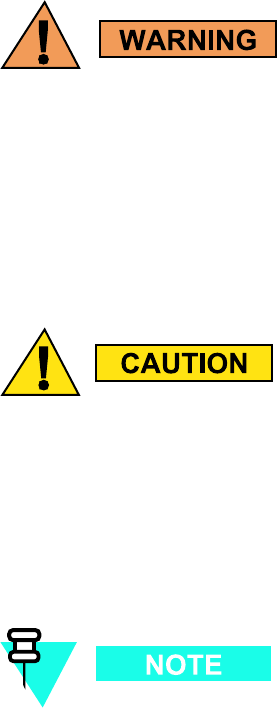
W arnings, cautions, and notes
Warnings, cautions, and notes■■■■■■■■■■■■■■■■■■■■■■■■■■■■■■■■■■■■■■■■■■■■■■■■■■■■■■■■■■■■■■
■
■
The following describes how warnings and cautions are used in this document and in all
documents of this Motorola document set.
Warnings
W arnings precede instructions that contain potentially hazardous situations. W arnings are
used to alert the reader to possible hazards that could cause loss of life or physical injury . A
warning has the following format:
W arning text and consequence for not following the instructions in the w arning.
Cautions
Cautions precede instructions and are used when there is a possibility of damage to systems,
software, or individual items of equipment within a system. However , this damage presents
no danger to personnel. A caution has the following format:
Caution text and consequence for not following the instructions in the caution.
Notes
A note means that there is a possibility of an undesirable situation or provides additional
information to help the reader understand a topic or concept. A note has the following format:
Note text.
8 68P09283A62 -2
PRELIMINARY A UG 2007

Safet y
Safety
■■■■■■■■■■■■■■■■■■■■■■■■■■■■■■■■■■■■■■■■■■■■■■■■■■■■■■■■■■■■■■
■
■
General safety
The following general safety guidelines apply to Motorola equipment:
•The power jack and mating plug of the power cable must meet International
Electrotechnical Commission (IEC) safety standards.
Refer to
Grounding Guideline for Cellular R adio Installations – 68P81150E62
.
•P ower down or unplug the equipment before servicing.
•Using non -Motorola parts for repair could damage the equipment or void warranty .
Contact Motorola W arranty and Repair for service and repair instructions.
•P ortions of Motorola equipment may be damaged from exposure to electrostatic discharge.
Use precautions to prevent damage.
Electromagnetic energy
Relevant standards (USA and EC) applicable when working with RF equipment are:
•
ANSI IEEE C95.1 -1991, IEEE Standard for Safety Levels with Respect to Human Exposure
to R adio Frequency Electromagnetic Fields, 3 kHz to 300 GHz.
•Council recommendation of 12 July 1999 on the limitation of exposure of the general
public to electromagnetic fields (0 Hz to 300 GHz) (1999/519/EC) and respective national
regulations.
•
Directive 2004/40/EC of the European P arliament and of the Council of 29 April 200
4 on
the minimum health and safety requirements regarding the exposure of workers to the
risks arising from physical agents (electromagnetic fields) (18th individual Directive within
the meaning of Article 16(1) of Directive 89/391/EEC).
68P09283A62 -2 9
A UG 2007 PRELIMINARY

Caring for the en vironment
Caring for the environment■■■■■■■■■■■■■■■■■■■■■■■■■■■■■■■■■■■■■■■■■■■■■■■■■■■■■■■■■■■■■■
■
■
The following information describes national or regional requirements for the disposal of
Motorola supplied equipment and for the approved disposal of surplus packaging.
Contact the Customer Network Resolution Center (CNRC) for assistance. The 24–hour
telephone numbers are listed at https://mynetworksupport.motorola.com . Select Customer
Network Resolution Center contact information . Alternatively if you do not have access
to CNRC or the internet, contact the Local Motorola Office.
In EU countries
The following information is provided to enable regulatory compliance with the European Union
(EU) directives identified and any amendments made to these directives when using Motorola
equipment in EU countries.
Disposal of Motorola equipment
European Union (EU) Directive 2002/96/EC W aste Electrical and Electronic Equipment (WEEE)
Do not dispose of Motorola equipment in landfill sites. In the EU , Motorola in conjunction
with a recycling partner ensures that equipment is collected and recycled according to the
requirements of EU environmental law .
Disposal of surplus packaging
European P arliament and Council Directive 94/62/EC P ackaging and P ackaging W aste
Do not dispose of surplus packaging in landfill sites. In the EU , it is the individual recipient’s
responsibility to ensure that packaging materials are collected and recycled according to the
requirements of EU environmental law .
In non -EU countries
In non -EU countries, dispose of Motorola equipment and all surplus packaging in accordance
with national and regional regulations.
10 68P09283A62 -2
PRELIMINARY A UG 2007
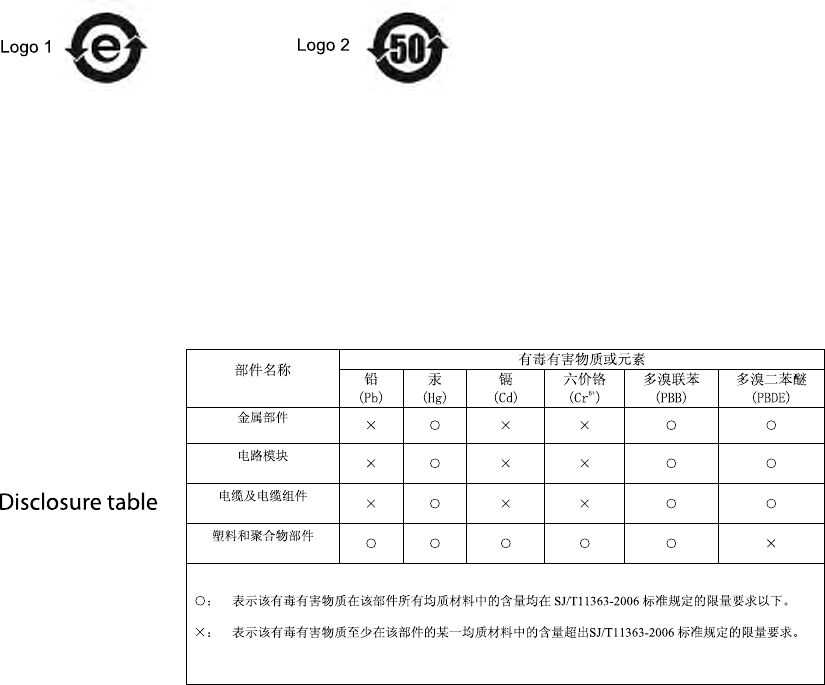
CMM labeling and disclosure table
CMM labeling and disclosure table■■■■■■■■■■■■■■■■■■■■■■■■■■■■■■■■■■■■■■■■■■■■■■■■■■■■■■■■■■■■■■
■
■
The P eople’s Republic of China require that our products comply with China Management
Methods (CMM) environmental regulations. (China Management Methods refers to the
regulation
Management Methods for Controlling P ollution by Electronic Information Products
.)
T wo items are used to demonstrate compliance; the label and the disclosure table.
The label is placed in a customer visible position on the product.
•Logo 1 means the product contains no substances in excess of the maximum concentration
value for materials identified in the China Management Methods regulation.
•Logo 2 means that the product may contain substances in excess of the maximum
concentration value for materials identified in the China Management Methods regulation,
and has an Environmental Friendly Use P eriod (EFUP) in years, fifty years in the example
shown.
Logo 1 Logo 2
The Environmental Friendly Use P eriod (EFUP) is the period (in years) during which the T oxic
and Hazardous Substances (T&HS) contained in the Electronic Information Product (EIP)
will not leak or mutate causing environmental pollution, or bodily injury from the use of the
EIP . The EFUP indicated by the Logo 2 label applies to a product and all its parts. Certain
field -replaceable parts, such as battery modules, can have a different EFUP and are marked
separately .
The Disclosure table is intended only to communicate compliance with China requirements.
It is not intended to communicate compliance with EU RoHS or any other environmental
requirements.
68P09283A62 -2 11
A UG 2007 PRELIMINARY
Motorola document set
Motorola document set■■■■■■■■■■■■■■■■■■■■■■■■■■■■■■■■■■■■■■■■■■■■■■■■■■■■■■■■■■■■■■
■
■
The Motorola document sets provide the information to operate, install, and maintain the
Motorola equipment.
Ordering documents and CD -ROMs
W ith internet access available, to view , download, or order documents (original or revised), visit
the Motorola Lifecycles Customer web page at https://mynetworksupport.motorola.com , or
contact your Motorola account representative.
W ithout internet access available, order hard copy documents or CD -ROMs with your Motorola
Local Office or Representative.
If Motorola changes the content of a document after the original printing date, Motorola
publishes a new version with the same part number but a different revision character .
Document banner denitions
A banner (oversized text on the bottom of the page, for example, PRELIMINARY — UNDER
DEVELOPMENT ) indicates that some information contained in the document is not yet approved
for general customer use.
Data encryption
In order to avoid electronic eavesdropping, data passing between certain elements in the
network is encrypted. In order to comply with the export and import requirements of particular
countries, this encryption occurs at different levels as individually standardized, or may not be
present at all in some parts of the network in which it is normally implemented. The document
set, of which this document is a part, covers encryption as if fully implemented. Because the
rules differ in individual countries, limitations on the encryption included in the particular
software being delivered, are covered in the Release Notes that accompany the individual
software release.
12 68P09283A62 -2
PRELIMINARY A UG 2007

Third P art y Computer Softw are and T r ademarks
Third Party Computer Software and Trademarks■■■■■■■■■■■■■■■■■■■■■■■■■■■■■■■■■■■■■■■■■■■■■■■■■■■■■■■■■■■■■■
■
■
Computer Software
The Motorola and 3rd P arty supplied Software (SW) products described in this instruction
manual may include copyrighted Motorola and other 3rd P arty supplied computer programs
stored in semiconductor memories or other media. Laws in the United States and other
countries preserve for Motorola and other 3rd P arty supplied SW certain exclusive rights for
copyrighted computer programs, including the exclusive right to copy or reproduce in any
form the copyrighted computer program. Accordingly , any copyrighted Motorola or other
3rd P arty supplied SW computer programs contained in the Motorola products described in
this instruction manual may not be copied (reverse engineered) or reproduced in any manner
without the express written permission of Motorola or the 3rd P arty SW supplier . Furthermore,
the purchase of Motorola products shall not be deemed to grant either directly or by implication,
estoppel, or otherwise, any license under the copyrights, patents or patent applications of
Motorola or other 3rd P arty supplied SW , except for the normal non -exclusive, royalty free
license to use that arises by operation of law in the sale of a product.
V endor Copyright
Apache Software F oundation Copyright 2002-2003 All Rights Reserved
Artesyn
Copyright 2002-2003 All Rights Reserved
CMU *
Copyright 2002-2003 All Rights Reserved
Freeware T ools / Utilities * Copyright 2002-2003 All Rights Reserved
P erformance T echnologies Copyright 2002-2003 All Rights Reserved
T elelogic Copyright 2002-2003 All Rights Reserved
QNX *
Copyright 2002-2003 All Rights Reserved
*= Freeware
Trademarks
Java™ T echnology and/or J2ME™ : Java and all other Java -based marks are trademarks or
registered trademarks of Sun Microsystems, Inc. in the U .S . and other countries.
UNIX® : UNIX is a registered trademark of The Open Group in the United States and other
countries.
68P09283A62 -2 13
A UG 2007 PRELIMINARY
Third P art y Computer Softw are and T r ademarks
14 68P09283A62 -2
PRELIMINARY A UG 2007

C h a p t e r
1
Introduction and Frame Identication■■■■■■■■■■■■■■■■■■■■■■■■■■■■■■■■■■■■■■■■■■■■■■■■■■■■■■■■■■■■■■
■
■
■
■
68P09283A62 -2 1 -1
A UG 2007 PRELIMINARY
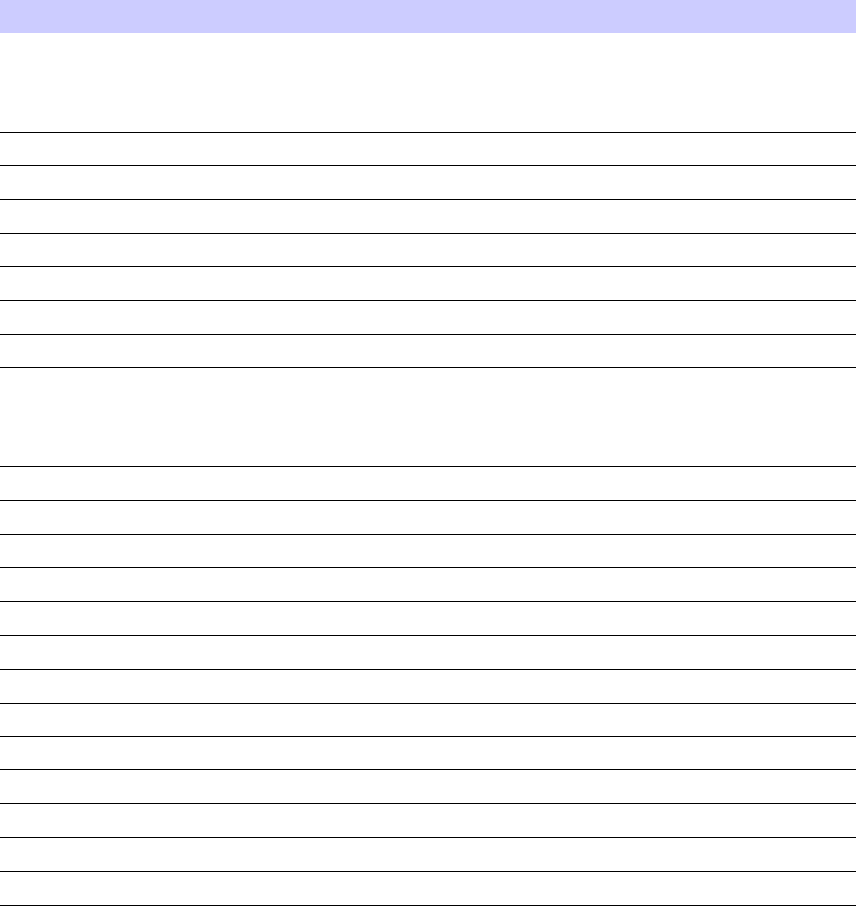
Abbreviations and Acron yms Chapter 1: Introduction and Fr ame Identication
Abbreviations and Acronyms■■■■■■■■■■■■■■■■■■■■■■■■■■■■■■■■■■■■■■■■■■■■■■■■■■■■■■■■■■■■■■
■
■
Abbreviations and Acronyms
T able 1 -1 identifies the equipment related abbreviations and acronyms used in this manual.
Table 1 -1 Abbreviations and Acron yms
Acronym
Denition
1X
One of two bandwidths currently defined in the IS -2000 CDMA
specification, which extends the capability of the IS -95A and B
specifications. 1X bandwidth provides wireless packet voice and data
transmission capability at up to 144 Kbps.
A Ampere or Amp
AC
Alternating Current
AN
Aggregation Node
A TP
Acceptance T est Plan
A WG American W ire Gauge
BSI
Baseband Switch Interface
BS S Base Station System
BS SAN
Base Station System (BS S) Access Network. The BS SAN consists of a
R adio Access Network (RAN) and an AN . It may also include a Digital
Access and Cross-connect System to support split backhaul and a Selector
Distribution Unit (SDU).
BTS
Base Transceiver Station or Base Transceiver Subsystem
CB
Circuit Breaker
CBSC
Centralized Base Station Controller
CCW
Counter Clockwise
CDMA
Code Division Multiple Access
CE
Channel Element
CW
Clockwise
DC Direct Current
DIV
Diversity
DMI
Digital Module Internal
DMM
Digital Multi-Meter
E -GPS
External-GPS
ESD
Electro-Static Discharge
Continued
1 -2 68P09283A62 -2
PRELIMINARY A UG 2007
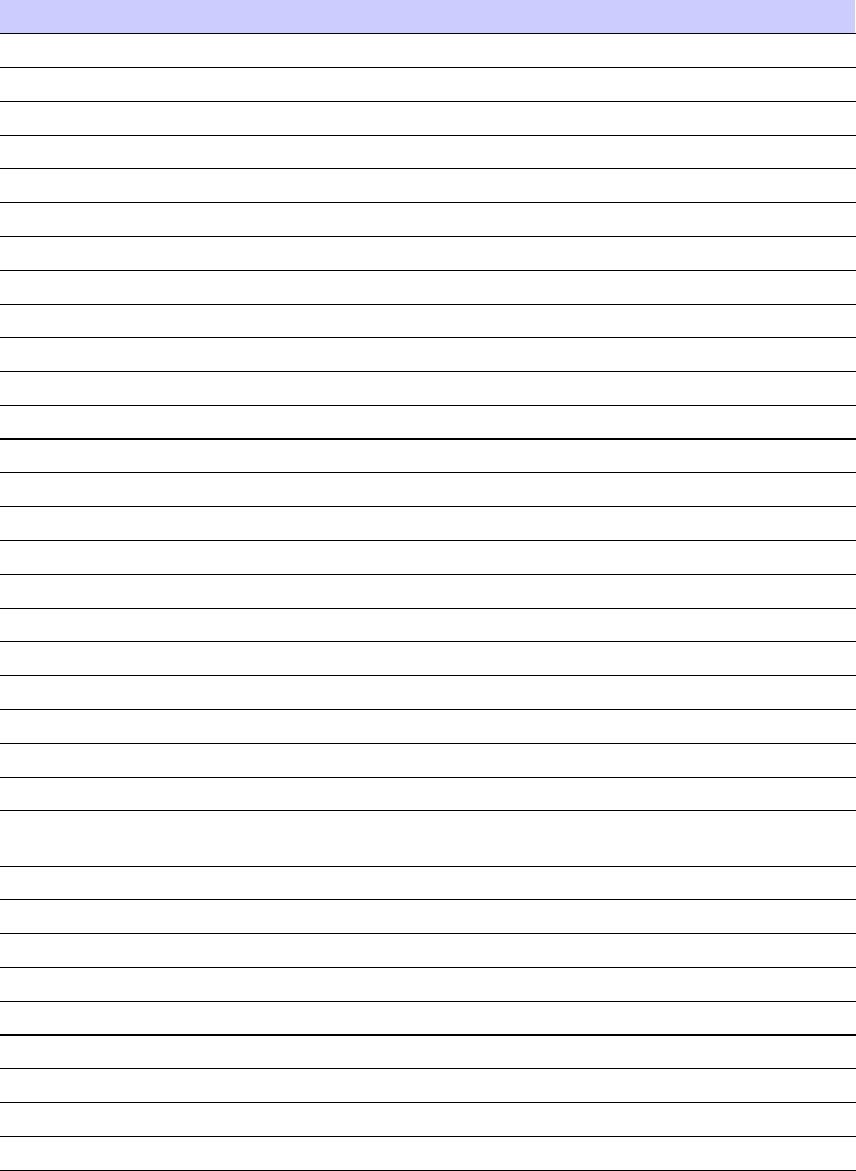
R20 1X UBS Macro B T S Hardw are Installation Abbreviations and Acron yms
Table 1 -1 Abbreviations and Acron yms (Continued)
Acronym
Denition
EV -DO
CDMA 1X Evolution - Data Only
FRU
Field Replaceable Unit
FWD
F orward
GND
Ground
GPS
Global P ositioning System
HSO
High Stability Oscillator
IDI
Interworking DMI Interconnect
IDRF
Integrated Duplexer RX Filter
I/O Input/Output
IP
Internet Protocol
IP/OP
Customer Alarm Input/Output
IS
Interim Standard
LAN
Local Area Network
LMF
Local Maintenance F acility
LMT
Local Maintenance T erminal
MGB
Master Ground Bar
MMI
Man Machine Interface
MMII
Mobility Manager II
MSN
Mobile Switching Network
MSO
Motorola Standard Oscillator
OMC-IP
Operations Maintenance Center - Internet Protocol
OMC-R
Operations Maintenance Center - R adio
P A
P ower Amplifier
PBH
P acket Backhaul: IP -based backhaul between the BTS and the network.
The UBS Macro BTS is configured for packet backhaul operation.
PC P ower Connector
PDU
P ower Distribution Unit
PPS or 1PPS
1 pulse per second
PSM
P ower Supply Module
QHSO
Quartz High Stability Oscillator
RAN
R adio Access Network
RF
R adio Frequency
RFL
Reflected
RGPS
Remote Global P ositioning System
Continued
68P09283A62 -2 1 -3
PRELIMINARY A UG 2007
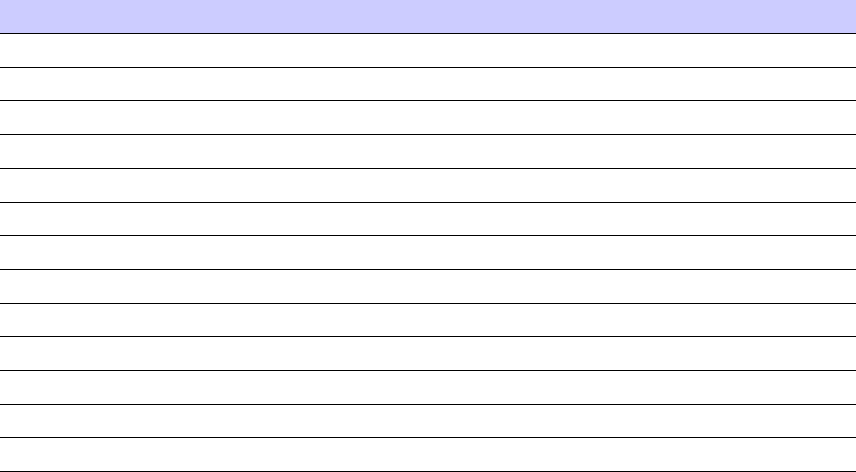
Abbreviations and Acron yms Chapter 1: Introduction and Fr ame Identication
Table 1 -1 Abbreviations and Acron yms (Continued)
Acronym
Denition
RU
R ack Unit
RX
Receive or Receiver
SDU
Selection and Distribution Unit
SPROC Site Processor
S SI
Site Span I/O or Site/Span Interface
TCH
Traffic Channel
TX
Transmit or Transmitter
UBS
Universal Base Station
UNO
Universal Network Operations
V
V olt
VP U
V ocoder Processing Unit
W W att
XMI
Transceiver Module Internal
1 -4 68P09283A62 -2
PRELIMINARY A UG 2007
R20 1X UBS Macro B T S Hardw are Installation Ov erview
Overview
■■■■■■■■■■■■■■■■■■■■■■■■■■■■■■■■■■■■■■■■■■■■■■■■■■■■■■■■■■■■■■
■
■
Scope of manual
This manual covers how to:
•Mount the equipment rack to the floor .
•Mount the pre -assembled/pre -cabled UBS Macro equipment on to the rack.
•Mount the optional power supply equipment on to the rack and install all of the associated
interconnect cabling.
•Mount the low -to -mid capacity expansion equipment on to the rack and install all of the
associated interconnect cabling.
•Install external cabling and wiring between the rack mounted UBS Macro equipment and
other BTS site equipment.
This manual is not intended to be used as a planning guide. All site plans and site specific
information must be decided, before starting the installation. The site specific information
determines the configuration to be used and the items and cabling required to support that
configuration.
This manual may be used in conjunction with site -specific configuration planning to determine
the site -specific expansion.
This manual does not provide information for the Acceptance T est Procedures (A TP) or software
loading.
Prerequisites
The following are the three major prerequisites:
•The procedure, tools, and equipment required for mounting the rack to the floor has
been specified by a Structural Engineer .
•All site preparations (including power) have been completed according to the site plan.
•All site planning and BTS configuration information is available.
Chapter 1 - Introduction and frame identication
This chapter provides a brief description of the information presented in the manual, frame
identification information, installation sequence, and a list of tools.
68P09283A62 -2 1 -5
PRELIMINARY A UG 2007
Ov erview Chapter 1: Introduction and Fr ame Identication
Chapter 2 – UBS Macro BTS installation procedure
This chapter provides figures showing the location of all UBS Macro connectors for external
cabling and wiring purposes, external cable run list, and a detailed installation sequence.
Installation procedures cover mounting items to the rack and installing the external cabling.
Chapter 3 - Low -to -Mid Capacity Frame Expansion Procedures
This chapter provides information and procedures needed for expanding the low -capacity UBS
Macro BTS starter/expansion frame to the mid -capacity frame configuration.
Chapter 4 - What’s next
This chapter provides procedures for cleaning up the site and the installation completion
checklist.
Equipment shipped assembled
The low -capacity , +27 V DC UBS Macro BTS is shipped pre -assembled on carrier strips with
all internal cabling installed. This pre -assembled equipment is delivered in a crate. A fter the
crate is unpacked, the low -capacity +27 V DC UBS Macro BTS assembly is ready to be rack
mounted. The carrier strips allow up to four people to carefully lift the assembly off the crate
packing onto the rack. The assembly can also be lifted via some mechanical aid (hoist, etc.)
attached to the lifting loops on the ends of the carrier strips. The carrier strips also provide easy
rack mounting. A fter the UBS Macro equipment is rack mounted, cables are connected between
the UBS Macro equipment and external site inputs/outputs.
Equipment shipped un -assembled
The low -to -mid capacity expansion equipment and associated cables are shipped in separate
individual containers. The additional expansion equipment is mounted into the low -capacity
frame and then the associated interconnect cables are installed.
F or -48 V DC or 220 V AC UBS Macro BTS applications, either a -48 V DC or AC PSM (P ower
Supply Module) shelf is required. The PSM shelf comes assembled, but without PSMs installed
in the shelf . Either up to two -48 V DC or up to two AC PSMs can be installed in the shelf . One
PSM is required for the low capacity configuration and the second PSM is for redundancy . The
PSM shelf without PSMs is delivered in a single box. Each PSM is delivered in a single box. The
PSM shelf is mounted at the bottom of the rack. Then the PSMs are installed in the PSM shelf .
The +27 V DC UBS Macro assembly is mounted just above the PSM shelf . The PSM +27 V DC
output cable is connected to the +27 V DC input cable on the +27 V DC UBS Macro assembly .
The site -48 V DC or 220 V AC power source is cabled/wired to the PSM shelf .
The Remote GPS (RGPS) head and associated cable are shipped un -assembled. The cable has to
be connected to the RGPS head along with the customer supplied mounting mast.
Most of the cable/wire connectors that are required to connect with the UBS Macro equipment
external site input/output connectors are supplied, but need to be assembled onto cables/wires.
Most of the cables/wires are supplied by the customer .
1 -6 68P09283A62 -2
PRELIMINARY A UG 2007
R20 1X UBS Macro B T S Hardw are Installation Ov erview
Follow the task sequence
The installation of the BTS is a defined sequence where one task relies on the previous task
being completed. Figures are used to aide in understanding cable and item placement.
Follow the site plan
Items and cables are covered in the installation procedure that may not apply to a specific site
configuration. Refer to the site plan to determine which items and cables are to be installed.
Skip over those procedures for items and cables that are not required.
Site cleanliness
While performing the procedures provided in this document, ensure that:
•The site is kept clean and free of dirt. Dust can circulate in the air for several days and
settle on all horizontal surfaces. Site equipment cooling fans can draw in dust particles,
causing damage to electrical contacts.
•All packing materials are removed from the equipment.
•All the tools that are not currently in use are picked -up as the installation progresses.
•All trash is removed from the site at the end of each day and after the installation is
complete.
•Equipment is covered with tarpaulin whenever possible.
•A shop van is used, when a procedure is performed that generates dust, such as drilling
or cutting.
Site manager
The site manager is in -charge of and responsible for the full site. The installer verifies a variety
of conditions with the site manager .
Color coding
Many of the RF connectors and cables are color coded. When the cables are installed, the cable
color code should match the color code of the connector .
The +27 V DC input/output cable connectors are color coded Orange while the -48 V DC
input/output cable connectors are color coded Blue. When these power connections are made,
make sure that the color of the mating connectors match.
68P09283A62 -2 1 -7
PRELIMINARY A UG 2007

Ov erview Chapter 1: Introduction and Fr ame Identication
•Not all cables and connectors are color coded.
•Some, but not all, of the color coding is called out in the installation procedures.
Rack vs. frame
F or purposes of this manual, the R ack is the piece of iron (metal) that the items are mounted
on. The Frame is the R ack with all the items mounted on it.
Required documentation
The following additional documents are required to install the BTS:
•
Grounding Guidelines for Cellular R adio Installations (Motorola part number 68P81150E62)
•
Site description
(as built) documents
•
Demarcation (Scope of W ork Agreement)
document
•
Equipment manuals
for non -Motorola equipment including:
Acutime™ Gold GPS Smart Antenna Kit User Guide
— Supplied with STLN6594
RGPS Head.
•
UBS (800 MHz) BTS Specification (B1)
or
UBS (1.9 GHz) BTS Specification (B1)
document,
whichever is applicable.
Equipment may vary from gures
The equipment shown in many of the figures is typical. The actual equipment appearance
may vary slightly .
1 -8 68P09283A62 -2
PRELIMINARY A UG 2007

R20 1X UBS Macro B T S Hardw are Installation Item identication
Item identication
■■■■■■■■■■■■■■■■■■■■■■■■■■■■■■■■■■■■■■■■■■■■■■■■■■■■■■■■■■■■■■
■
■
The R20 UBS Macro BTS supports single band 800 MHz or 1.9 GHz RF band, up to
two XMIs, up to two DMIs and one S SI. UBS Macro BTS frame configurations with up
to four XMIs and up to five DMIs will be available in the future.
UBS Macro BTS frames
UBS Macro BTS frames are configured for either +27 V DC operation, -48 V DC operation, or
220 V AC operation.
UBS Macro BTS frames are also configured for low , mid or high capacity . Low capacity frames,
like the starter frame shown in Figure 1 -2 , can be expanded to add more capacity . Mid -capacity
frames, like the frame shown in Figure 1 -3 , can be expanded to add more capacity . A high
capacity frame, like the expanded frames shown in Figure 1 -4 and Figure 1 -5 can be expanded
to add more capacity , if it is not already fully expanded. A BTS site with a fully expanded high
capacity frame may be further expanded by adding a second frame for more capacity .
High capacity UBS Macro BTS frames and BTS sites with multiple UBS Macro BTS
frames are not currently available.
68P09283A62 -2 1 -9
PRELIMINARY A UG 2007
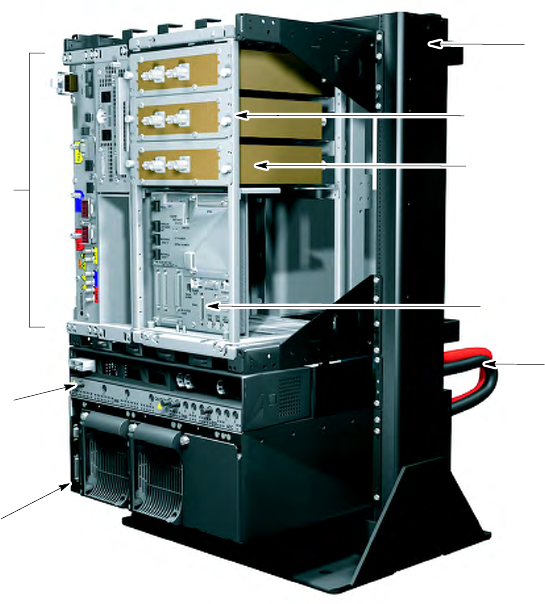
Item identication Chapter 1: Introduction and Fr ame Identication
Figure 1 -1 shows a UBS Macro BTS low -tier/low -capacity frame. The capacity of this
configuration is not expandable.
Figure 1 -1 UBS Macro B T S low -tier/low -capacit y fr ame (1000 mm r ack)
ti-cdma-05993.eps
IDRF (Integrated Duplexer and
RX Filter) Shelf
SSI (Site Span I/O); SSI 1
XMI (Transceiver Module Internal) Shelf
- One XMI; XMI 1 (800 MHz or 1.9 GHz
See Notes 2, 3)
- Up to 2 DMIs (Digital Module Internal)
just right of XMI 1
- DMI 1, top; optional DMI 2 or empty
housing, bottom
- IDRF (Integrated Duplexer and RX Filter)
Shelf; in right side of XMI shelf
PDU (+27 V DC Power Distribution Unit)
- One: +27 V DC XMI Power Connector
(PC) and 90A Circuit Breaker (CB)
- Up to 2: +27 V DC DMI PCs and 20A CBs
- One: +27 V DC SSI PC and 20A CB
- No +27 V DC Accessory PCs and CBs
PSM (Power Supply Module) Shelf #1
(See Notes 4,5,6)
- Up to 2 PSMs
- Empty PSM slot with ller panel
- PSM 1 through 3 (left-to-right)
NOTES:
1. Interconnect cabling not shown for clarity.
2. 800 MHz equipment shown; 1.9 GHz similar.
3. 800 MHz XMI is 86 mm wide. 1.9 GHz XMI is 106.3 mm wide.
4. PSM shelf is optional and used instead of +27 V DC power Input.
5. PSM shelf is either -48 V DC or AC.
6. Only -48 V DC PSMs can be used in -48 V DC PSM shelf. Only AC PSMs can be used in AC PSM shelf.
PSM Shelf #1
+27 V DC Power
Cabling
Equipment
Mounting Rack
IDRF (800 MHz or 1.9 GHz
See Note 2)
- Up to 3 IDRFs; one per sector
- IDRF sector 1 through sector 3
(top-to-bottom)
- Antenna RF I/O, front
- BTS RF I/O, rear
1 -10 68P09283A62 -2
PRELIMINARY A UG 2007
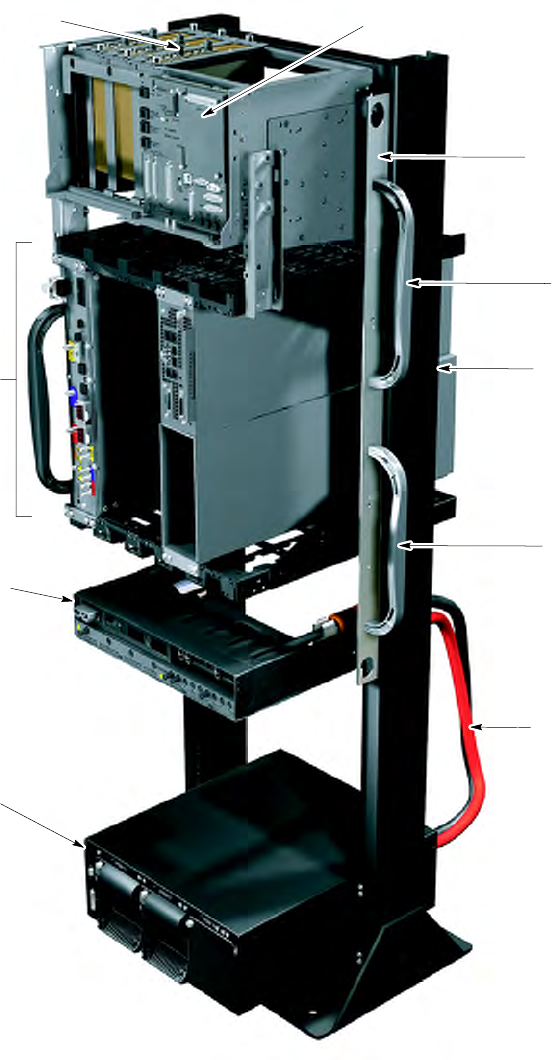
R20 1X UBS Macro B T S Hardw are Installation Item identication
Figure 1 -2 shows a typical low capacity UBS Macro BTS expandable frame. This frame is
expandable to mid -capacity configuration. Expansion to high -capacity configuration is not
currently available.
Figure 1 -2 Low capacit y UBS Macro B T S starter fr ame (1800 mm r ack)
ti-cdma-05994.eps
IDRF (Integrated Duplexer and RX Filter) Shelf
- Up to 3 IDRFs (800 MHz or 1.9 GHz
See Note 2); one per sector
- IDRF sector 1 through sector 3 (left-to-right)
- Antenna RF I/O, top
- BTS RF I/O, bottom
SSI (Site Span I/O)
- One SSI; SSI 1
XMI (Transceiver Module Internal) Shelf
- One XMI; XMI 1 (800 MHz or 1.9 GHz
See Notes 2, 3) XMI shelf slot 1
- Up to 2 DMIs (Digital Module Internal)
XMI shelf slot 4
- DMI 1, top; optional DMI 2 or empty
housing, bottom
PDU (+27 VDC Power Distribution Unit)
See Note 8
- One: +27 VDC XMI Power Connector
(PC) and 90A Circuit Breaker (CB)
- Up to 2: +27 VDC DMI PCs and 20A CBs
- One: +27 VDC SSI PC and 20A CB
- No +27 VDC Accessory PCs and CBs
PSM (Power Supply Module) Shelf #1
(See Notes 4,5,6)
- Up to 3 PSMs
- Empty PSM slot with ller panel
- PSM 1 through 3 (left-to-right)
NOTES:
1. Interconnect cabling not shown for clarity.
2. 800 MHz equipment shown; 1.9 GHz similar.
3. 800 MHz XMI is 86 mm wide. 1.9 GHz XMI is 106.3 mm wide.
4. PSM shelf is optional and used instead of+27 VDC power Input.
5. PSM shelf is either -48 VDC or AC.
6. Only -48 VDC PSMs can be used in -48 VDC PSM shelf. Only AC PSMS can be used in AC PSM shelf.
7. Carrier strips are removable.
8. PDU may be moved down 6 rack units to ease future expansion.
PSM Shelf #1
+27 VDC Power
Cabling
Handle
Equipment
Mounting Rack
Handle
Carrier Strip with
Removable Lifting
Handles (one strip
on each side of rack)
See Note 7
68P09283A62 -2 1 -11
PRELIMINARY A UG 2007
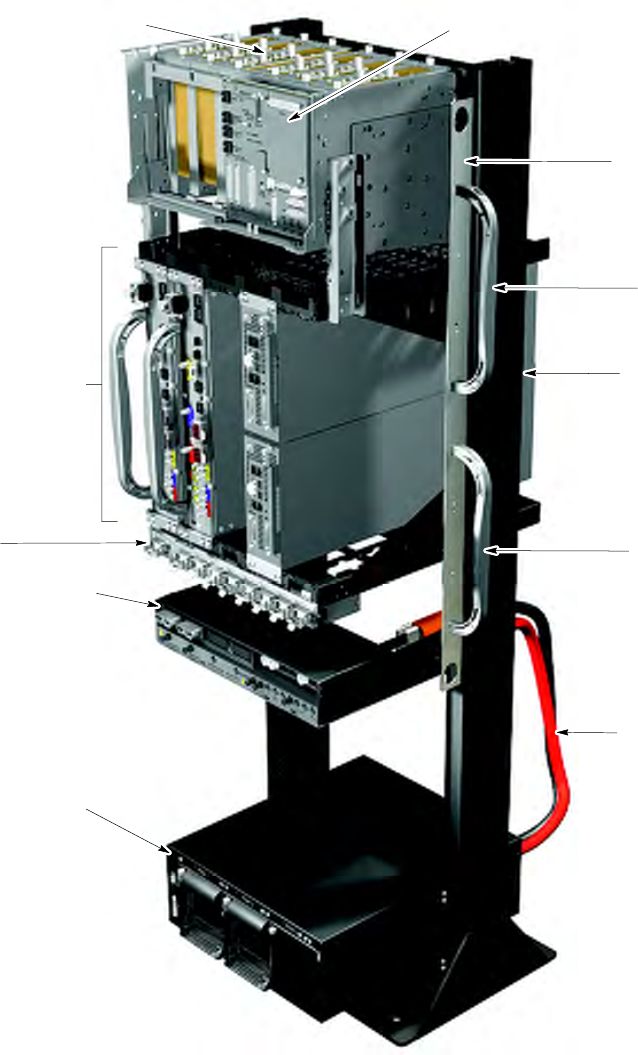
Item identication Chapter 1: Introduction and Fr ame Identication
Figure 1 -3 shows a UBS Macro BTS mid -capacity frame. The mid -capacity configuration is
an expansion of the low -capacity configuration. This frame is expandable to high -capacity
configuration, but the high -capacity configuration is not currently available.
Figure 1 -3 UBS Macro B T S mid -capacit y fr ame (1800 mm r ack)
ti-cdma-05995.eps
IDRF (Integrated Duplexer and RX Filter) Shelf
- Up to 6 IDRFs (800 MHz or 1.9 GHz
See Note 2); two sets of IDRFs,
each set with one IDRF per sector
- IDRF sector 1 through sector 3 (left-to-right)
- Antenna RF I/O, top
- BTS RF I/O, bottom
SSI (Site Span I/O)
- One SSI; SSI 1
XMI (Transceiver Module Internal) Shelf
- Two XMIs (800 MHz or 1.9 GHz
See Notes 2, 3); XMI 1, XMI 2 in
XMI shelf slots 1, 2
- Two DMIs (Digital Module Internal)
XMI shelf slot 4
- DMI 1, top; DMI 2, bottom
PDU (+27 VDC Power Distribution Unit)
See Note 8
- One: +27 VDC XMI Power Connector
(PC) and 90A Circuit Breaker (CB)
- Up to 2: +27 VDC DMI PCs and 20A CBs
- One: +27 VDC SSI PC and 20A CB
- No +27 VDC Accessory PCs and CBs
PSM (Power Supply Module) Shelf #1
(See Notes 4,5,6)
- Up to 3 PSMs
- Empty PSM slot with filler panel
- PSM 1 through 3 (left-to-right)
NOTES:
1. Interconnect cabling not shown for clarity.
2. 800 MHz equipment shown; 1.9 GHz similar.
3. 800 MHz XMI is 86 mm wide. 1.9 GHz XMI is 106.3 mm wide.
4. PSM shelf is optional and used instead of+27 VDC power Input.
5. PSM shelf is either -48 VDC or AC.
6. Only -48 VDC PSMs can be used in -48 VDC PSM shelf. Only AC PSMS can be used in AC PSM shelf.
7. Carrier strips are removable.
8. PDU may be moved down 6 rack units to ease future expansion.
PSM Shelf #1
+27 VDC Power
Cabling
Handle
Equipment
Mounting Rack
Handle
Carrier Strip with
Removable Lifting
Handles (one strip
on each side of rack)
See Note 7
RX Splitter
1 -12 68P09283A62 -2
PRELIMINARY A UG 2007
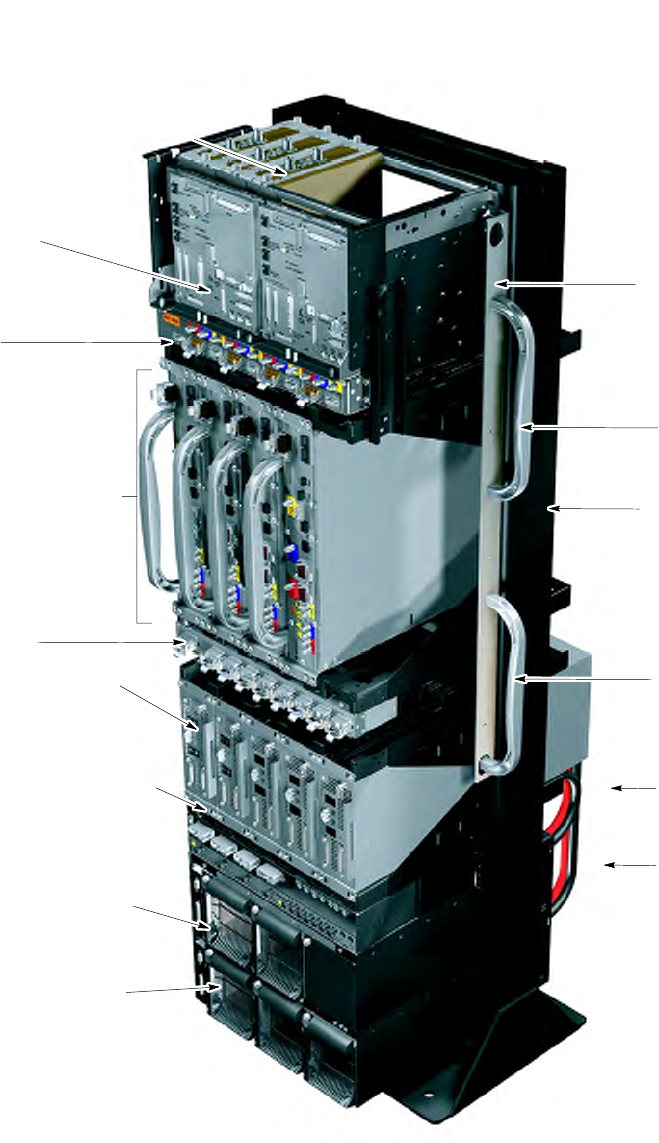
R20 1X UBS Macro B T S Hardw are Installation Item identication
Figure 1 -4 shows a typical fully expanded high capacity 800 MHz UBS Macro BTS frame.
Figure 1 -4 High capacit y 800 MHz UBS Macro B T S fully expanded fr ame
ti-cdma-05996.eps
NOTES:
1. Interconnect cabling not shown for clarity.
2. 800 MHz equipment shown.
3. 800 MHz XMI is 86 mm wide.
4. PSM shelves are optional and used
instead of+27 VDC power Input.
PSM (Power Supply Module) Shelf #1
(See Notes 4,5,6)
- Up to 3 PSMs
- PSM 1 through 3 (left-to-right)
PSM (Power Supply Module) Shelf #2
(See Notes 4,5,6)
- Up to 2 PSMs
- Empty PSM slot with filler panel
- PSM 1 through 3 (left-to-right)
PDU (+27 VDC Power Distribution Unit)
- Up to 4: +27 VDC XMI Power Connectors
(PCs) and 90A Circuit Breakers (CBs)
- Up to 5: +27 VDC DMI PCs and 20A CBs
- Up to 2: +27 VDC SSI PCs and 20A CBs
- Up to 2 sets of 3: +27 VDC Accessory PCs
- Up to 2: 10A CBs; one CB per set of 3+27
VDC Accessory PCs. None equipped.
DMI (Digital Module Internal) Shelf
- Up to 5 DMIs
- DMI 1 through 5 (left-to-right)
RX Splitter
XMI (Transceiver Module Internal) Shelf
- Up to 4 XMIs (See Notes 2, 3);
XMI 1through XMI 4 in XMI shelf
slots 1 through 4 (left-to-right)
- One Ancillary slot 5 shown empty
TX Combiner, 4:1
(See Note 2)
SSI (Site Span I/O) Shelf
- Two SSIs
- SSI 2, SSI 1 (left-to-right)
IDRF (Integrated Duplexer and RX Filter) Shelf
- Up to 3 IDRFs (See Note 2); one per sector
- IDRF sector 1 through 3 (left-to-right)
- Antenna RF I/O, top
- BTS RF I/O, bottom
Carrier Strip with
Removable Lifting
Handles (one strip
on each side of rack)
See Note 7
Handle
Equipment
Mounting Rack
Handle
PSM Shelf #2
+27 VDC Power
Cabling
PSM Shelf #1
+27 VDC Power
Cabling
5. Both PSM shelves are either -48 VDC or AC.
6. Only -48 VDC PSMs can be used in -48 VDC PSM shelf.
Only AC PSMs can be used in AC PSM shelf.
7. Carrier strips are removable
8. A high capacity frame requires
an IDI/BSI module not shown
because it is still being developed.
68P09283A62 -2 1 -13
PRELIMINARY A UG 2007
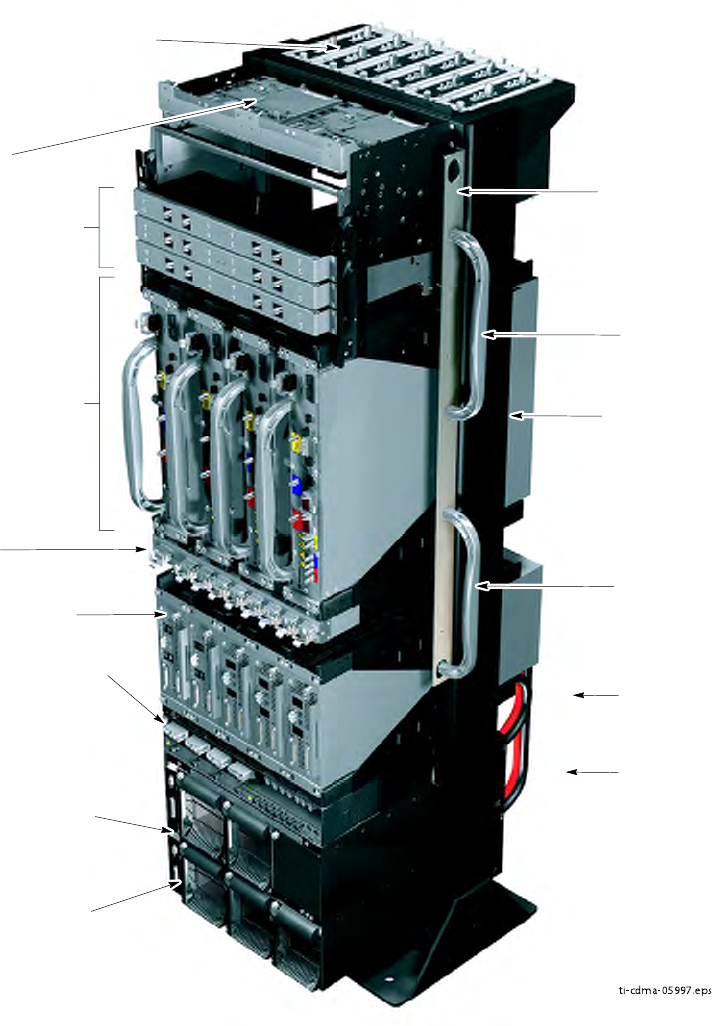
Item identication Chapter 1: Introduction and Fr ame Identication
Figure 1 -5 shows a typical fully expanded high -capacity 1.9 GHz UBS Macro BTS frame.
Figure 1 -5 High -capacit y 1.9 GHz UBS Macro B T S fully expanded fr ame (1800 mm
r ack)
PSM (Power Supply Module) Shelf #1
(See Notes 4,5,6)
- Up to 3 PSMs
- PSM 1 through 3 (left-to-right)
PSM (Power Supply Module) Shelf #2
(See Notes 4,5,6)
- Up to 2 PSMs
- Empty PSM slot with filler panel
- PSM 1 through 3 (left-to-right)
PDU (+27 VDC Power Distribution Unit)
- Up to 4: +27 VDC XMI Power Connectors
(PCs) and 90A Circuit Breakers (CBs)
- Up to 5: +27 VDC DMI PCs and 20A CBs
- Up to 2: +27 VDC SSI PCs and 20A CBs
- Up to 2 sets of 3: +27 VDC Ancillary PCs
- Up to 2: 10A CBs; one CB per set of 3+27
VDC Accessory PCs. None equipped.
DMI (Digital Module Internal) Shelf
- Up to 5 DMIs
- DMI 1 through 5 (left-to-right)
RX Splitter
XMI (Transceiver Module Internal) Shelf
- Up to 4 XMIs (See Notes 2, 3);
XMI 1through XMI 4 in XMI shelf
slots 1 through 4 (left-to-right)
Six 2:1 TX Cavity Combiners
(See Note 2)
SSI (Site Span I/O) Shelf
- Up to 2 SSIs
- SSI 2, SSI 1 (left-to-right)
IDRF (Integrated Duplexer and RX Filter) Shelf
- Up to 6 IDRFs (See Note 2); two sets of IDRFs,
each set with one IDRFper sector
- IDRF sector 1 through sector 3 (left-to-right)
- Antenna RF I/O, top
- BTS RF I/O, bottom
Carrier Strip with
Removable Lifting
Handles (one strip
on each side of rack)
See Note 7
Handle
Equipment
Mounting Rack
Handle
PSM Shelf #2
+27 VDC Power
Cabling
PSM Shelf #1
+27 VDC Power
Cabling
ti-cdma-05997.eps
NOTES:
1. Interconnect cabling not shown for clarity.
2. 1.9 GHz equipment shown.
3. 1.9 GHz XMI is 106.3 mm wide.
4. PSM shelves are optional and used
instead of+27 VDC power Input.
5. Both PSM shelves are either -48 VDC or AC.
6. Only -48 VDC PSMs can be used in -48 VDC PSM shelf.
Only AC PSMs can be used in AC PSM shelf.
7. Carrier strips are removable
8. A high capacity frame requires
an IDI/BSI module not shown
because it is still being developed.
1 -14 68P09283A62 -2
PRELIMINARY A UG 2007
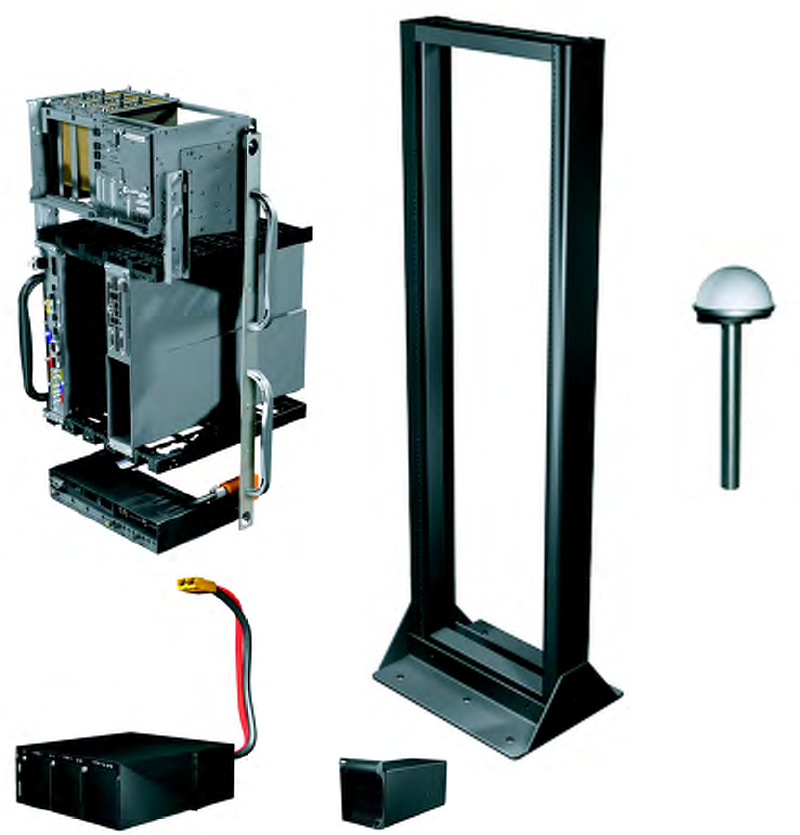
R20 1X UBS Macro B T S Hardw are Installation Item identication
Items to be installed
Figure 1 -6 shows the items to be installed.
Figure 1 -6 Items to install
ti-cdma-06008.eps
Low Capacity, +27 VDC
UBS Macro BTS Assembly
Tall Rack
Optional -48V DC or 220 V AC
PSM Shelf (without PSMs)
-48V DC or 220 V AC PSM
(up to two; one required,
two for redundancy)
Optional
RGPS Head
68P09283A62 -2 1 -15
PRELIMINARY A UG 2007
T ools and materials Chapter 1: Introduction and Fr ame Identication
Tools and materials■■■■■■■■■■■■■■■■■■■■■■■■■■■■■■■■■■■■■■■■■■■■■■■■■■■■■■■■■■■■■■
■
■
Required tools and materials
The following tools and materials are required to perform the installation:
•Battery driver , capable of 3.95 N -m to 5.09 N -m (35 -45 in -lb) torque
•T20 and T25 TORX bits with 12 inch extension
•T orque drivers; 1 N -m, 2.3 N -m, 4.8 N -m +/ - 10%
•8 mm SMA connector torque wrench; 1.02 N -m (9 in -lb) +/ - 10%
•19 mm N -type connector torque wrench; 4.3 N -m (38 in -lb) +/ - 10%
•Phillips screwdriver
•Flat screwdriver
•3/8 -inch ratchet -5.6 N -m (50 in -lb)
•8 -mm socket
•19 -mm socket
•10 -mm deep set socket
•9/16 -inch socket
•3/16 -inch socket
•Side cutters
•Dust mask
•Safety glasses
•Ear plugs
•Marker for marking outline on floor
•T ape measure with millimeter scale, capable measuring up to 1200 mm or with inch scale,
capable measuring up to 48 inches
•Shop vacuum
•Cable tie -wraps
•Scissors or knife
•0.25 W SMA -type terminators for any unused directional port connectors on an
IDRF - customer supplied
1 -16 68P09283A62 -2
PRELIMINARY A UG 2007

R20 1X UBS Macro B T S Hardw are Installation T ools and materials
•50 W N -type terminators for any unused TX/RX connectors on an IDRF - customer supplied
•Digital Multi -Meter (DMM) Fluke Model 8062A with Y8134 test lead kit or equivalent; used
for precision DC and AC measurements, requiring 4 -1/2 digits.
•One DC connector housing per DC power feed (see T able 2 -8 for quantity of power feeds)
Orange DC connector housing used for +27 V DC application (see T able 2 -14 for
part information).
Blue DC connector housing used for –48 V DC application (see T able 2 -15 for part
information).
•DC connector cable clamps for power cable (see T able 2 -14 or T able 2 -15 for part
information).
•DC connector housing contacts/lugs for power cable (see T able 2 -14 or T able 2 -15 for
part information).
•Crimper tool - Anderson P ower Products part number 1368 - Hydraulic hand tool, maximum
cable size of 300 MCM.
Other tools are required to install the rack to the floor . The method of installing the rack to the
floor , as specified by a Structural Engineer , determines what additional tools are required.
Recommended tools
The following tools are not required, but they may make the installation easier:
•Long screwdriver extension
•Long socket wrench extension
•Mechanical hoist capable of lifting 100 kg, 2 m high
•Banding cutter
68P09283A62 -2 1 -17
PRELIMINARY A UG 2007
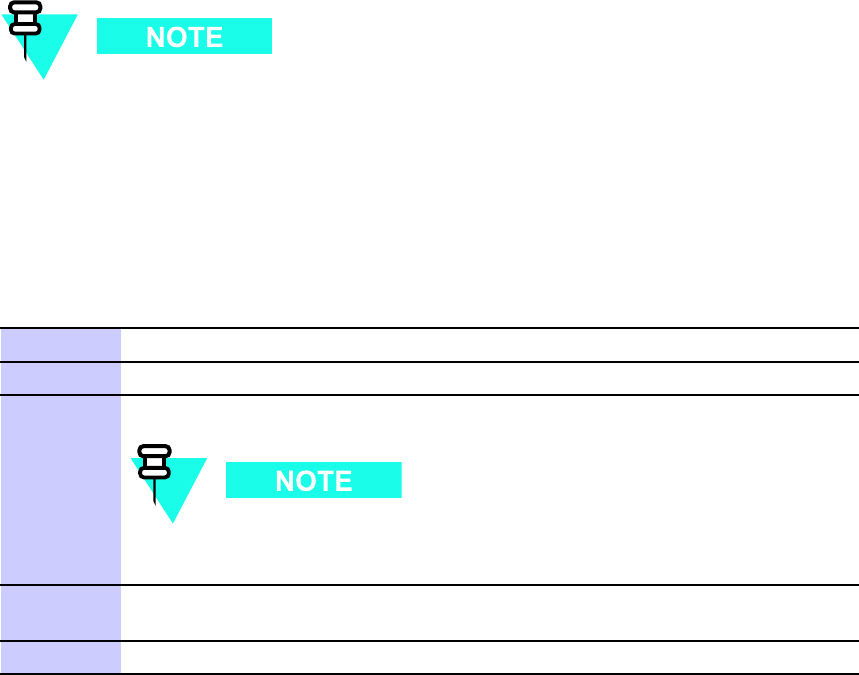
Unpacking Instructions Chapter 1: Introduction and Fr ame Identication
Unpacking Instructions
■■■■■■■■■■■■■■■■■■■■■■■■■■■■■■■■■■■■■■■■■■■■■■■■■■■■■■■■■■■■■■
■
■
Unpacking the carrier strip assembly
The UBS Macro BTS carrier strip assembly includes the low -capacity frame equipment
pre -mounted and cabled. This assembly consists of the following equipment:
•One set of IDRFs, up to three IDRFs.
•One S SI
•One XMI
•One DMI
•PDU with one +27 V DC input power feed and circuit breaker/output power connector
assemblies as follows: XMI 1, DMI 1, DMI 2 and S SI 1.
The STGN4034 Installation Kit is also packaged with the UBS Macro carrier strip
assembly . The installation kit contains all of the M5 x 12 mm screws needed to rack
mount the equipment.
The UBS Macro BTS carrier strip assembly is shipped in a large carton that is banded to a pallet.
F ollow the steps in Procedure 1 -1 to unpack the carrier strip assembly .
Procedure 1 -1 Unpacking the carrier strip assembly
1
Cut the bands that hold the carton to the pallet.
2
Lift the carton up and off of the pallet. Remove the cut bands
3
Remove the inner carton support (see Figure 1-7 ).
The carrier strip assembly is sitting on a wooden support (see
Figure 1-8 ).
4
Locate the STGN4034 Installation Kit that is packaged with the UBS Macro
carrier strip assembly .
5
Inspect the carrier strip assembly for damage.
1 -18 68P09283A62 -2
PRELIMINARY A UG 2007
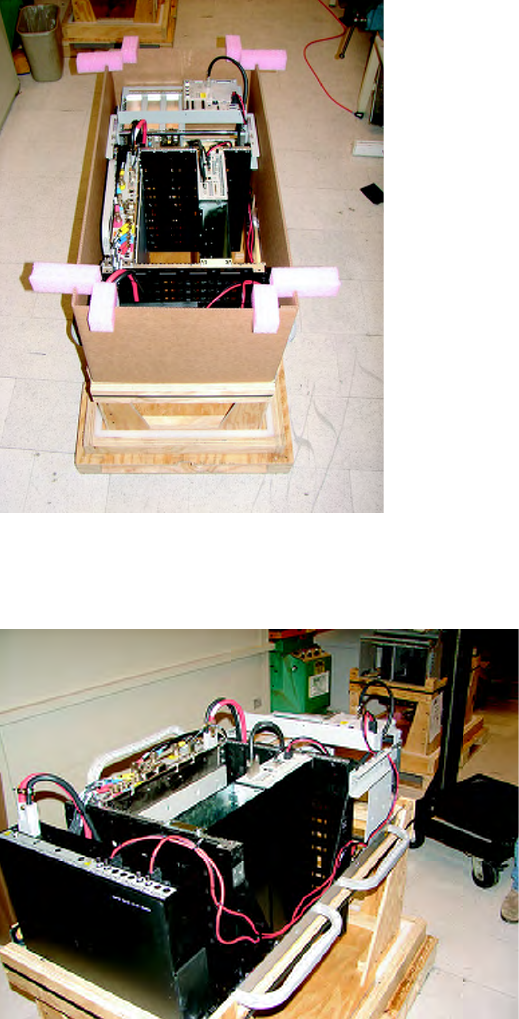
R20 1X UBS Macro B T S Hardw are Installation Unpacking Instructions
Figure 1 -7 Carrier strip assembly with inner carton support
ti-cdma-06026.eps
Figure 1 -8 Carrier strip assembly with inner carton support remo v ed
ti-cdma-06027.eps
68P09283A62 -2 1 -19
PRELIMINARY A UG 2007

Unpacking Instructions Chapter 1: Introduction and Fr ame Identication
Unpacking accessory equipment
UBS Macro BTS accessory equipment is shipped in smaller cartons. The quantity of cartons
is dependent on the BTS site configuration and options. F ollow the steps in Procedure 1 -2 to
unpack the accessory equipment.
Procedure 1 -2 Unpacking accessory equipment
1
Open an accessory equipment carton.
2
Inspect the contents of the carton for damage.
3
V erify that the carton contains all of the equipment stated on the packing list.
4
Repeat this procedure for each carton in the shipment.
1 -20 68P09283A62 -2
PRELIMINARY A UG 2007

C h a p t e r
2
UBS Macro BTS Installation Procedure■■■■■■■■■■■■■■■■■■■■■■■■■■■■■■■■■■■■■■■■■■■■■■■■■■■■■■■■■■■■■■
■
■
■
■
68P09283A62 -2 2 -1
A UG 2007 PRELIMINARY
Ov erview Chapter 2: UBS Macro B T S Installation Procedure
Overview
■■■■■■■■■■■■■■■■■■■■■■■■■■■■■■■■■■■■■■■■■■■■■■■■■■■■■■■■■■■■■■
■
■
Introduction
This chapter provides the information and procedures to install the items and cabling for the
UBS Macro BTS . Both pictorial and textual information is presented.
The installation is broken into a set of tasks. Each set of tasks is broken down into a set of steps.
Individual tasks or steps are based on the overall installation sequence and must not be
performed randomly .
Structural engineer
A Structural Engineer has to determine the method and equipment needed to mount the rack to
the floor .
Required items
F or each set of tasks, a list of tools and items is given that covers those specific tasks.
A full list of tools is given in T ools and materials on page 1 - 16 .
Cabling and conguration options
All of the configurations require unique cables and/or items. Installation of all cables and all
items is covered. When applicable, the cabling and configuration options are called out. Not all
cables or items covered in this manual should be installed. Consult the site plan to determine
exactly what items to install.
Color coding
Many of the connectors and cables are color coded. As the cables are installed, the cable
color code should match the color code of the connector . Not all cables and connectors are
color coded.
Some, but not all, of the color coding is called out in the installation procedures. The scheme of
the color codes is shown in T able 2 -1 and T able 2 -2 .
2 -2 68P09283A62 -2
PRELIMINARY A UG 2007
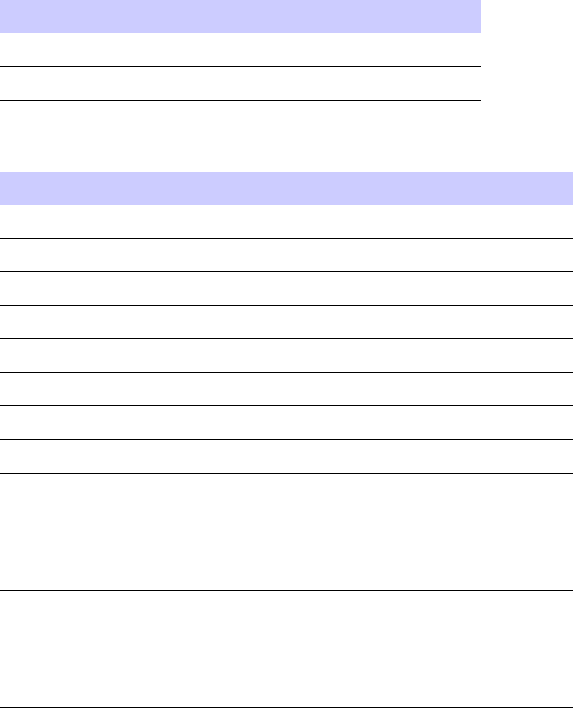
R20 1X UBS Macro B T S Hardw are Installation Ov erview
Table 2 -1 Color code – DC power connectors/cables
Color
Represents
ORANGE +27 V DC P ower
BL UE
-48 V DC P ower
Table 2 -2 Color code - RF Equipment and Connectors/Cables
Color
Represents
ORANGE 800 MHz RF equipment
BL UE
1.9 GHz RF equipment
GREEN 2.1 GHz RF equipment
RED
Sector 1
BL UE
Sector 2
YELLOW Sector 3
GREY
RFL (reflected) Main
BROWN
RFL DIV (reflected diversity)
WHITE
F or RF use, it can mean:
•Main
•FWD (forward main)
BLACK F or RF use, it can mean:
•Diversity
•FWD DIV (forward diversity)
68P09283A62 -2 2 -3
PRELIMINARY A UG 2007
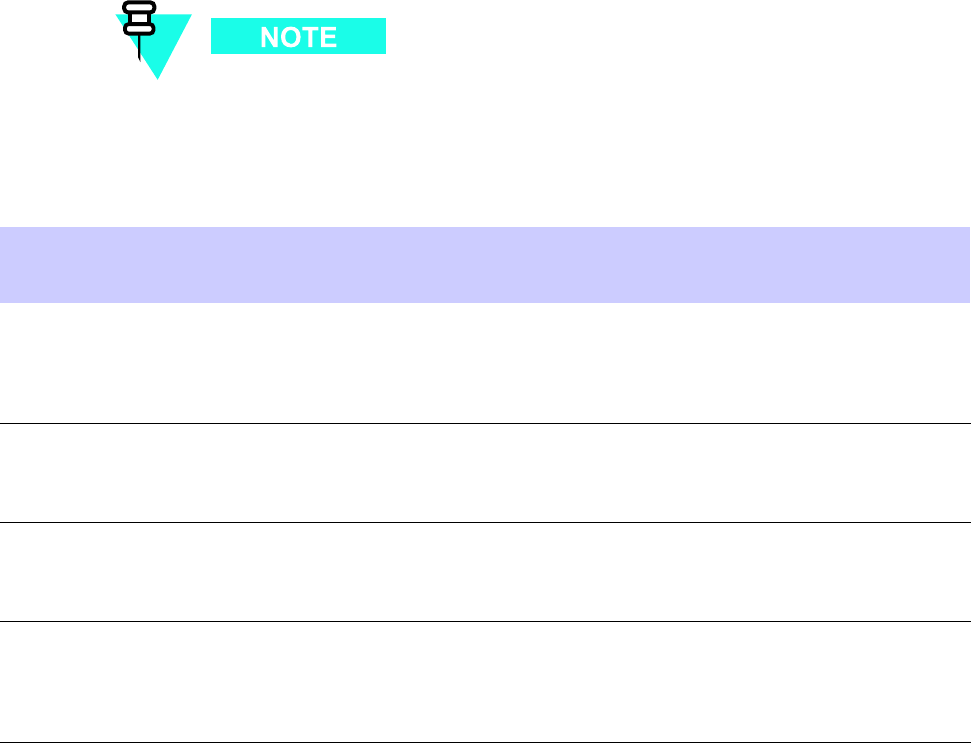
Cable list, diagr ams and connectors Chapter 2: UBS Macro B T S Installation Procedure
Cable list, diagrams and connectors■■■■■■■■■■■■■■■■■■■■■■■■■■■■■■■■■■■■■■■■■■■■■■■■■■■■■■■■■■■■■■
■
■
Overview
This section gives a UBS Macro BTS external input/output (I/O) cable run list – a list of cables
and the end connection points. This can be used as a check -off sheet during installation. F or any
item that cables connect to, that item and the associated connectors are shown.
UBS Macro BTS external I/O cable run list
T able 2 -3 gives the UBS Macro BTS external input/output cable run list. Not all cables are
needed for all configurations.
Each row in T able 2 -3 is a separate unique cable run even if the reference designator
and the part number are duplicated.
Table 2 -3 UBS Macro B T S external I/O cable run list
From T oReference
(used in
manual)
Part number
Item
Connector
Item
Connector
Notes
DD
Customer
R ack Double-studs
Site Master
Ground Bar
(MGB)
Customer
Earth Ground
Cable/W ire
(4 A WG
or larger
diameter)
NN
One of:
3086039H10
through H14
(Note 1)
RGPS
Head
12-pin
Circular
(Deutsch)
RGPS
Lightning
Arrester
RGPS
Lightning
Arrester
RGPS Head
Cable,
shielded
twisted pair
AA
3086433H14 S SI RGPS
(15-pin D)
RGPS
Lightning
Arrester
RGPS
Lightning
Arrester
RGPS Head
Cable,
shielded
twisted pair
W
CGDS19797321 S SI SP ANS
(37-pin D)
Customer Equipment
T1/E1 Bal.,
shielded
twisted
pair cable
(Note 2)
Continued
2 -4 68P09283A62 -2
PRELIMINARY A UG 2007
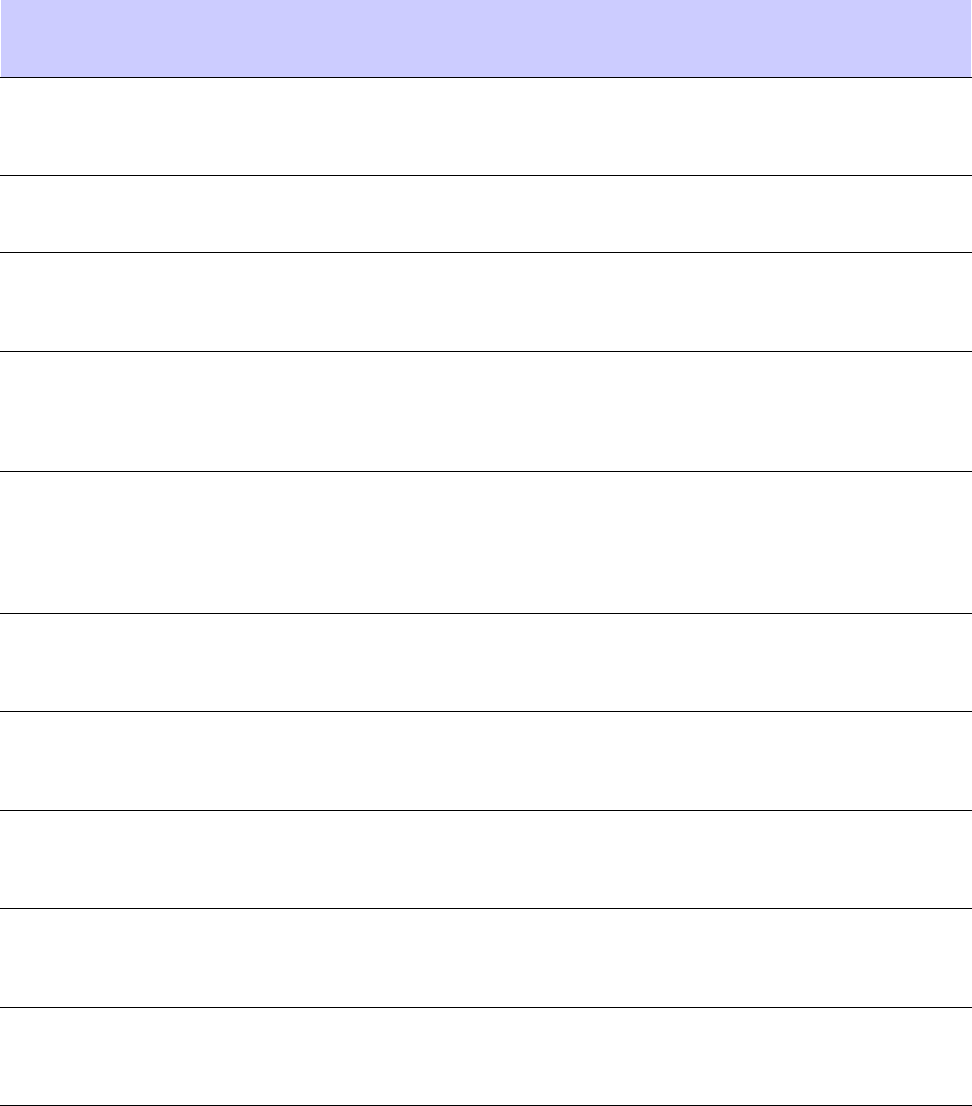
R20 1X UBS Macro B T S Hardw are Installation Cable list, diagr ams and connectors
Table 2 -3 UBS Macro B T S external I/O cable run list (Continued)
From T oReference
(used in
manual)
Part number
Item
Connector
Item
Connector
Notes
None
Customer S SI
(E1
Daughter
Card)
SP AN
RX/TX #
(BNCs)
Customer Equipment
E1 Unbal.
75-Ohm Coax
Up to 8 cables
(Note 2)
X
CGDS19797321 S SI CUSTOMER
IP 1-12 OP 1-4
(37-pin D)
Customer Equipment Customer
Input/Output
(IP/OP)
X
CGDS19797321 S SI CUSTOMER
IP 13-24
OP 5-8
(37-pin D)
Customer Equipment Customer
Input/Output
(IP/OP)
DC Customer PDU +27
V DC
P ower
Input
Cable
Orange
(2-contact,
Anderson
SB -350)
DC P ower
W ires; Red
& Black
Orange
(2-contact,
Anderson
SB -350)
+27 V DC
P ower From
Customer
Source
CC Customer -48 V
DC PSM
Shelf
P ower
Input
Cable
Blue
(2-contact,
Anderson
SB -350)
DC P ower
W ires; Blue
& Black
Blue
(2-contact,
Anderson
SB -350)
-48 V DC
P ower From
Customer
Source
AC Customer AC PSM
Shelf
AC Input
T erminal Block
Customer Equipment AC P ower
From
Customer
Source
None
Customer Sector 1
IDRF
TX/RX MAIN
(N-type,
coaxial)
Sector
1 TX/RX
Main Ant.
Cable
N-type,
coaxial
RF Ant.,
50-Ohm
Coaxial
(Note 3)
None
Customer Sector 2
IDRF
TX/RX MAIN
(N-type,
coaxial)
Sector
2 TX/RX
Main Ant.
Cable
N-type,
coaxial
RF Ant.,
50-Ohm
Coaxial
(Note 3)
None
Customer Sector 3
IDRF
TX/RX MAIN
(N-type,
coaxial)
Sector
3 TX/RX
Main Ant.
Cable
N-type,
coaxial
RF Ant.,
50-Ohm
Coaxial
(Note 2)
None
Customer Sector 1
IDRF
RX DIV
(N-type,
coaxial)
Sector 1
RX Div .
Ant. Cable
N-type,
coaxial
RF Ant.,
50-Ohm
Coaxial
(Note 2)
Continued
68P09283A62 -2 2 -5
PRELIMINARY A UG 2007
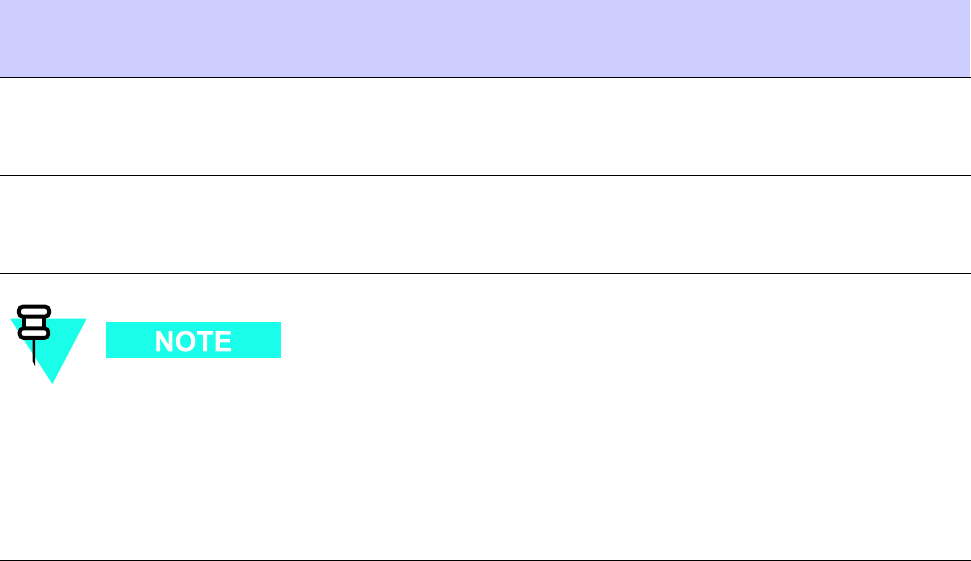
Cable list, diagr ams and connectors Chapter 2: UBS Macro B T S Installation Procedure
Table 2 -3 UBS Macro B T S external I/O cable run list (Continued)
From T oReference
(used in
manual)
Part number
Item
Connector
Item
Connector
Notes
None
Customer Sector 2
IDRF
RX DIV
(N-type,
coaxial)
Sector 2
RX Div .
Ant. Cable
N-type,
coaxial
RF Ant.,
50-Ohm
Coaxial
(Note 2)
None
Customer Sector 3
IDRF
RX DIV
(N-type,
coaxial)
Sector 3
RX Div .
Ant. Cable
N-type,
coaxial
RF Ant.,
50-Ohm
Coaxial
(Note 2)
1. Cables 3086039H10 through H14 are various lengths; where the part number suffix
indicates the following cable lengths: H10 = 15 m (50 ft), H11 = 38 m (125 ft), H12 =
76 m (250 ft), H13 =152 m (500 ft) and H14 = 304 m (1000 ft). Cables H10 and H11
are included in Motorola option T472AG and T472AH, respectively . Cables H12, H13
and H14 are included in Motorola option T472AJ , T472AK and T472AL respectively .
2. Cable may be connected to a lightning arrester .
Connector locations
Figure 2 -1 through Figure 2 -4 show the items that external cables connect to . F or each
connector , the name is stated and where the associated cable goes.
IDRF I/O details
Figure 2 -1 shows connector locations and usage for the 800 MHz IDRF .
Figure 2 -2 shows connector locations and usage for the 1.9 GHz IDRF .
2 -6 68P09283A62 -2
PRELIMINARY A UG 2007
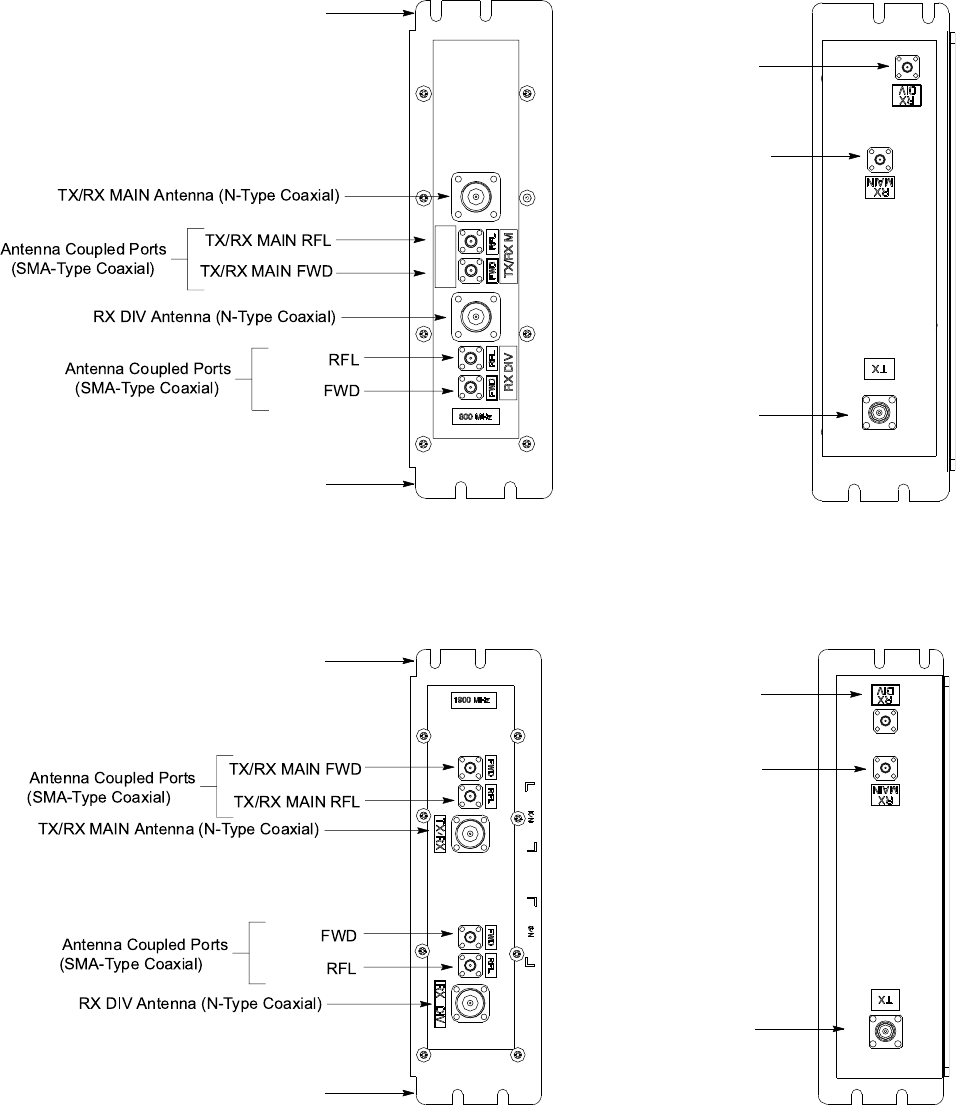
R20 1X UBS Macro B T S Hardw are Installation Cable list, diagr ams and connectors
Figure 2 -1 800 MHz IDRF I/O connectors
TOP VIEW BOTTOM VIEW
RX DIV to XMI
(QMA-Type Coaxial)
TX from XMI
(Sector TX RF)
(QN-Type Coaxial)
RX MAIN to XMI
(QMA-Type Coaxial)
ti-cdma-06010.eps
TX/RX MAIN Antenna (N-T ype Coaxial)
Antenna Coupled Ports
(SMA-Type Coaxial)
TX/RX MAIN RFL
TX/RX MAIN FWD
Antenna Coupled Ports
(SMA-Type Coaxial)
RX DIV
RFL
RX DIV
FWD
RX DIV Antenna (N-T ype Coaxial)
(Sector RX RF)
(Sector RX RF)
TX/RX M
RX DIV
FWD CPLR
LABEL
Mounting Tab
Mounting Tab
NOTE:
1. Connector locations may vary
depending on the IDRF supplier.
Figure 2 -2 1.9 GHz IDRF I/O connectors
TOP VIEW BOTTOM VIEW
RX DIV to XMI
(QMA-Type Coaxial)
TX from XMI
(Sector TX RF)
(QN-Type Coaxial)
RX MAIN to XMI
(QMA-Type Coaxial)
ti-cdma-06009.eps
TX/RX MAIN Antenna (N-T ype Coaxial)
Antenna Coupled Ports
(SMA-Type Coaxial)
RX DIV
RFL
RX DIV
FWD
Antenna Coupled Ports
(SMA-Type Coaxial) TX/RX MAIN RFL
TX/RX MAIN FWD
RX DIV Antenna (N-T ype Coaxial)
Mounting Tab
(Sector RX RF)
(Sector RX RF)
Mounting Tab
NOTE:
1. Connector locations may vary
depending on the IDRF supplier.
68P09283A62 -2 2 -7
PRELIMINARY A UG 2007
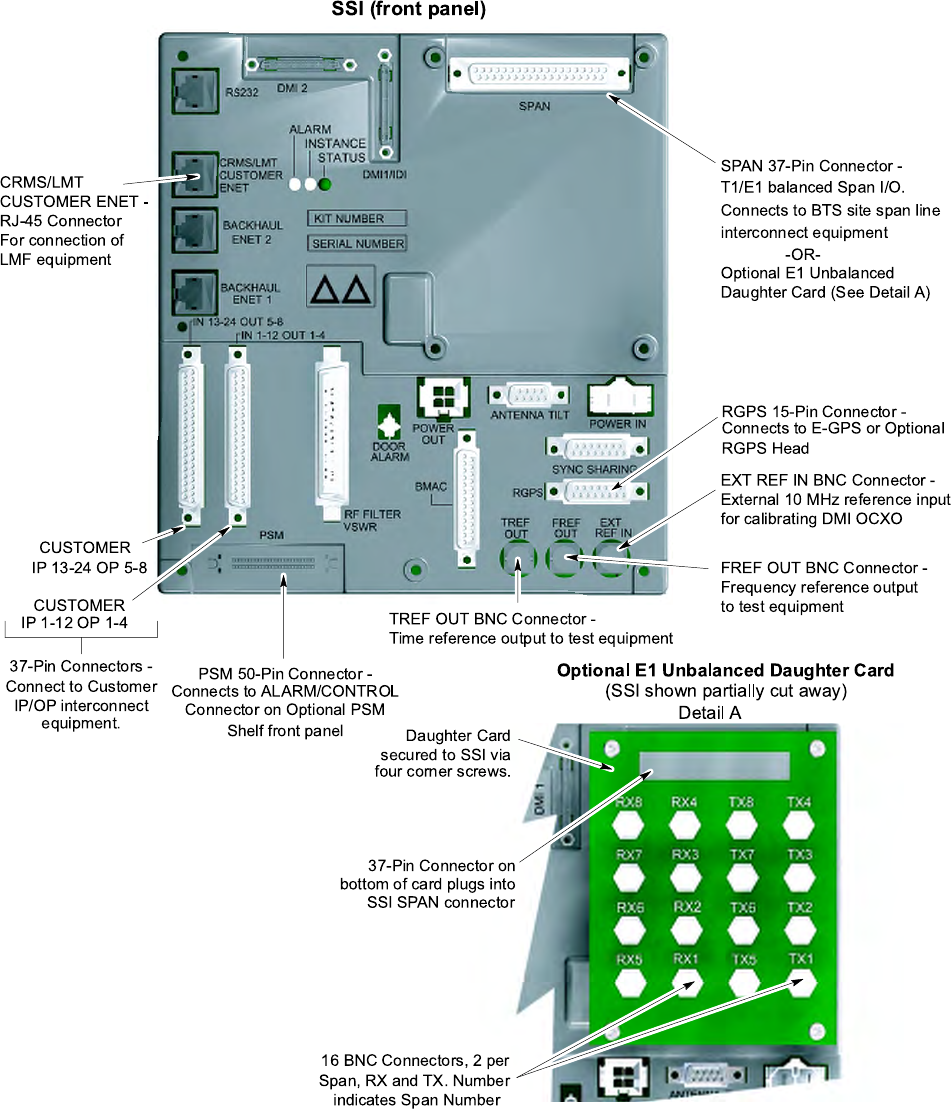
R20 1X UBS Macro B T S Hardw are Installation Cable list, diagr ams and connectors
Figure 2 -3 S SI front panel connectors
SSI (front pane l)
CUST OMER
IP 13-24 OP 5-8
CUST OMER
IP 1-12 OP 1-4
37-Pin Connectors -
Connect to Customer
IP/OP interconnect
equipment.
PSM 50-Pin Connector -
Connects to ALARM/CONTROL
Connector on Optional PSM
Shelf front panel
RGPS 15-Pin Connector -
Connects to E-GPS or Optional
RGPS Head
SP AN 37-P in Connector -
T1/E1 balanced Span I/O.
Connects to BTS site span line
interconnect equipment
-OR-
Optional E1 Unbalanced
Daughter Card (See Detail A)
Detail A
Optional E1 Unbalanced Daughter Card
(SSI sh own partially cut away)
Dau ghter Card
sec ured to SSI via
four corner scre ws.
37-Pin C onnector on
bottom o f card plugs into
SSI SP AN connector
16 BNC Conn ectors , 2 per
Span , RX an d TX. Number
indicates S pan Number
ti-cdma-05698.eps
TREF OUT BNC Connector -
Time reference o utput to test equipment
FREF OUT BNC Connector -
Frequenc y refere nce output
to test equipmen t
EXT REF IN BNC Connector -
External 10 MH z reference input
for calibrating DM I OCXO
CRMS/LMT
CUST OMER EN ET -
RJ-45 Connector
For connection o f
LMF equipment
68P09283A62 -2 2 -9
PRELIMINARY A UG 2007
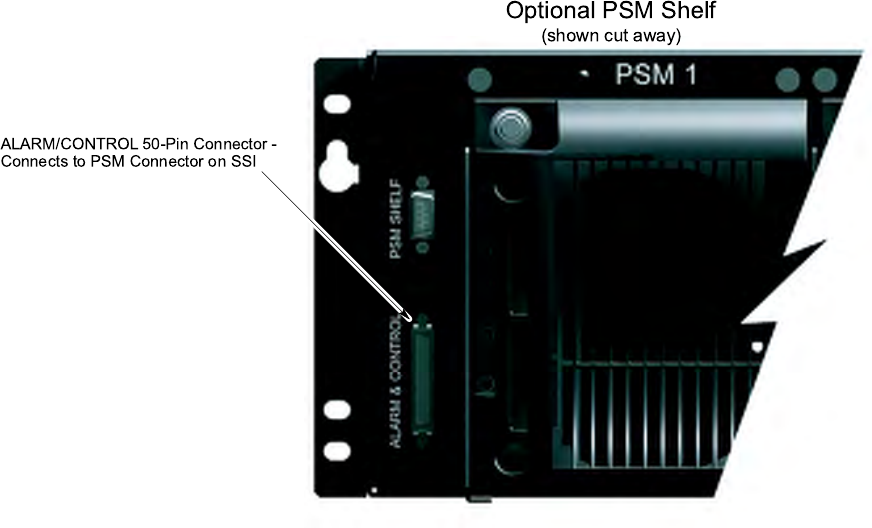
Cable list, diagr ams and connectors Chapter 2: UBS Macro B T S Installation Procedure
PSM shelf front panel I/O details
Figure 2 -4 shows the front panel connector locations and usage for the optional PSM shelf .
Figure 2 -4 PSM shelf front panel connectors
ti-cdma-05699.eps
Optional PSM Shelf
(sh own cut away)
ALARM/CONTROL 50-Pin Connector -
Connects to PSM Connector on SSI
2 -10 68P09283A62 -2
PRELIMINARY A UG 2007
R20 1X UBS Macro B T S Hardw are Installation Full installation sequence
Full installation sequence■■■■■■■■■■■■■■■■■■■■■■■■■■■■■■■■■■■■■■■■■■■■■■■■■■■■■■■■■■■■■■
■
■
Overview
The installation of the UBS Macro BTS is composed of two parts to be performed in this order:
1. V erifying site and equipment
2. Physical installation
Once the site is verified, the BTS can be physically installed.
Details to perform each part are given here along with any prerequisites.
Prerequisites
This document is not a planning guide and is not meant to provide planning information. All site
planning, including power requirements and installation of site power , must be completed before
performing the installation. The site verification will help verify this prerequisite has been met.
A Structural Engineer has been consulted and has determined the method to mount the rack to
the floor .
Verifying site and equipment
This can be performed at any time prior to the physical installation. V erifying site and equipment
is composed of two portions to be performed in this order:
1. Site verifications - Refer to Site verification on page 2 - 15 to verify the site.
2. Unpack and identify the equipment - Refer to Unpacking Instructions on page 1 - 18 and
unpack the various cartons. Refer to Figure 1 -6 and verify the correct equipment is
present. The exact number and type of equipment is site dependent.
Physical installation
Recommendations
Motorola recommends performing the physical installation all at once and not in multiple stages.
Motorola recommends installing cable ties to eliminate confusion and clutter .
68P09283A62 -2 2 -11
PRELIMINARY A UG 2007

Full installation sequence Chapter 2: UBS Macro B T S Installation Procedure
Color code
F ollow the color codes for the cables and connectors when applicable. Refer to Overview on
page 2 - 2 of this chapter for a detailed description of the color codes.
Default values
Unless otherwise specified, use these default values during the installation.
•All screws are M5 x 12 mm and require a T25 TORX bit. These screws are included in the
STGN4034 Installation Kit that is packaged with the UBS Macro carrier strip assembly .
•T orque values are to be within +/ -10% of value shown.
•Tighten screws and bolts to 4.77 N -m (42 in -lb).
•Maximum torque for the IDRF screws is 2.37 N -m (21 in -lb).
•Tighten SMA connectors to 1.02 N -m (9 in -lb).
•Tighten N -connectors on cables to 4.3 N -m (38 in -lb).
Preview of installation tasks
This section provides a preview of all of the tasks to be performed to install the UBS Macro
BTS as well the sequence of those tasks. Each specific task is detailed in its own section later
in this manual.
Each item number below corresponds to a specific task number . The task number is
used to identify the task and its occurrence within the overall installation sequence.
** indicates an optional task. The system configuration determines if the optional task
is to be performed or if it can be skipped.
P erform the following tasks in the order shown when installing the UBS Macro BTS .
1. ** Install the optional RGPS head and route cable (NN) to the BTS site. Skip this task if
the optional RGPS head is not required.
2. Mount rack to floor using the hardware, tools, and procedures defined by your Structural
Engineer . Motorola recommends using 6 carbon steel grade 8.8 M12 bolts.
3. Install earth ground wire/cable (DD) between the site Master Ground Bar (MGB) and
equipment rack. A ttach ground wire to the top of equipment rack using 2 studs/nuts and a
10 mm socket and ratchet. Tighten to 5.65 N -m (50 in -lb).
4. ** P erform this task for -48 V DC or 220 V AC UBS only . Install the PSM shelf to the bottom
of the rack using 6 screws; three screws on each left and right side. Install the appropriate,
-48 V DC or 220 V AC , PSMs into PSM shelf slots 1 and 2.
2 -12 68P09283A62 -2
PRELIMINARY A UG 2007
R20 1X UBS Macro B T S Hardw are Installation Full installation sequence
5. Mount the UBS Macro BTS carrier strip assembly to the rack at the predetermined height.
First, measure and install 2 hanger screws in the rack rails; one screw on each left and
right side at the proper height. Second, two or four people lift the UBS Macro BTS carrier
strip assembly via the carrier strip handles and hang the assembly on the 2 hanger screws
in the rack rails. Install 2 screws in the keyholes at the bottom of each carrier strip. Third,
completely fasten the UBS assembly/carrier strips using 22 more screws; 1 screws on each
left and right side. Completely tighten these 22 crews. Then completely tighten the 4
screws in the keyholes.
6. ** Install the additional equipment required to expand the UBS Macro BTS low -capacity
starter/expansion frame to the mid -capacity frame configuration. If the initial UBS Macro
BTS installation is for a low -capacity frame configuration, skip this task and go to T ask
7. P erform this task only if the initial UBS Macro BTS installation is for a mid -capacity
frame configuration.
7. ** F or -48 V DC or 220 V AC UBS only , connect the +27 V DC power output cable from
the rear of the PSM shelf to the +27 V DC power input cable on the rear of the PDU .
Connect the 50 -conductor cable (supplied with PSM shelf) between the PSM shelf front
panel ALARM/CONTROL connector and S SI PSM connector .
8. Route the customer supplied TX/RX main and RX diversity antenna cables to the front of
the Integrated Duplexer RX Filters (IDRFs) at the top of the frame. Connect each antenna
cable to the corresponding IDRF connector .
9. Connect customer supplied 0.25 W , 50 -Ohm, SMA -type terminators to unused directional
coupler port connectors on the front of the IDRFs.
10. ** Install optional RGPS cable (AA). Connect the 15 -pin D -connector to the RGPS connector
on the front of the S SI. Route the loose end of the cable to the RGPS lightning arrester and
connect the wires there. Skip this task if the optional RGPS head is not required.
11. ** Install T1/E1 balanced span I/O cable (W). Connect the 37 -pin D -connector to the SP AN
connector on the front of the S SI. Route the loose end of the cable to the site span line
interconnect equipment and connect the wires.
12. ** Install E1 unbalanced span I/O coaxial cables (customer supplied). Route 75 -Ohm
coaxial cables, with BNC connectors, from the site span line interconnect equipment to the
S SI. Connect each cable to the corresponding BNC connector on the S SI E1 daughter card.
13. ** Install Customer Alarm Input/Output (IP/OP) cables (X). Connect the 37 -pin D -connector
to the corresponding CUSTOMER IP 1 -12 OP 1 -4 connector and CUSTOMER IP 13 -24 OP
5 -8 connector on the front of the S SI. Route the loose end of the cables to the customer
IP/OP interconnect equipment and connect the wires.
14. ** Ensure that all circuit breakers are open on the PDU . F or +27 V DC UBS only: attach an
Orange 2 -contact DC connector to Red and Black wires. Connect this Orange connector
to the +27 V DC input power cable on the rear of the PDU . Route the loose ends of the
wires to the site +27 V DC source and connect the wires.
15. ** Ensure that all circuit breakers are open on the PDU . F or -48 V DC UBS only: attach a
Blue 2 -contact DC connector to Blue and Black wires. Connect this Blue connector to the
Blue DC INP UT connector on the rear of the -48 V DC PSM shelf . Route the loose ends of
the wires to the site -48 V DC source and connect the wires.
16. ** Ensure that all circuit breakers are open on the PDU . F or 220 V AC UBS only: attach
customer supplied wiring and conduit for 220 V AC lines. Connect wires and required
insertion bridges to the AC INP UT terminal block on the rear of the AC PSM shelf . Route
the loose ends of the wires to the site 220 V AC source and connect the wires.
68P09283A62 -2 2 -13
PRELIMINARY A UG 2007
Full installation sequence Chapter 2: UBS Macro B T S Installation Procedure
A fter performing all of the necessary tasks, complete the installation by performing the
following:
•Clean up the site.
•Fill out installation check off sheet.
2 -14 68P09283A62 -2
PRELIMINARY A UG 2007